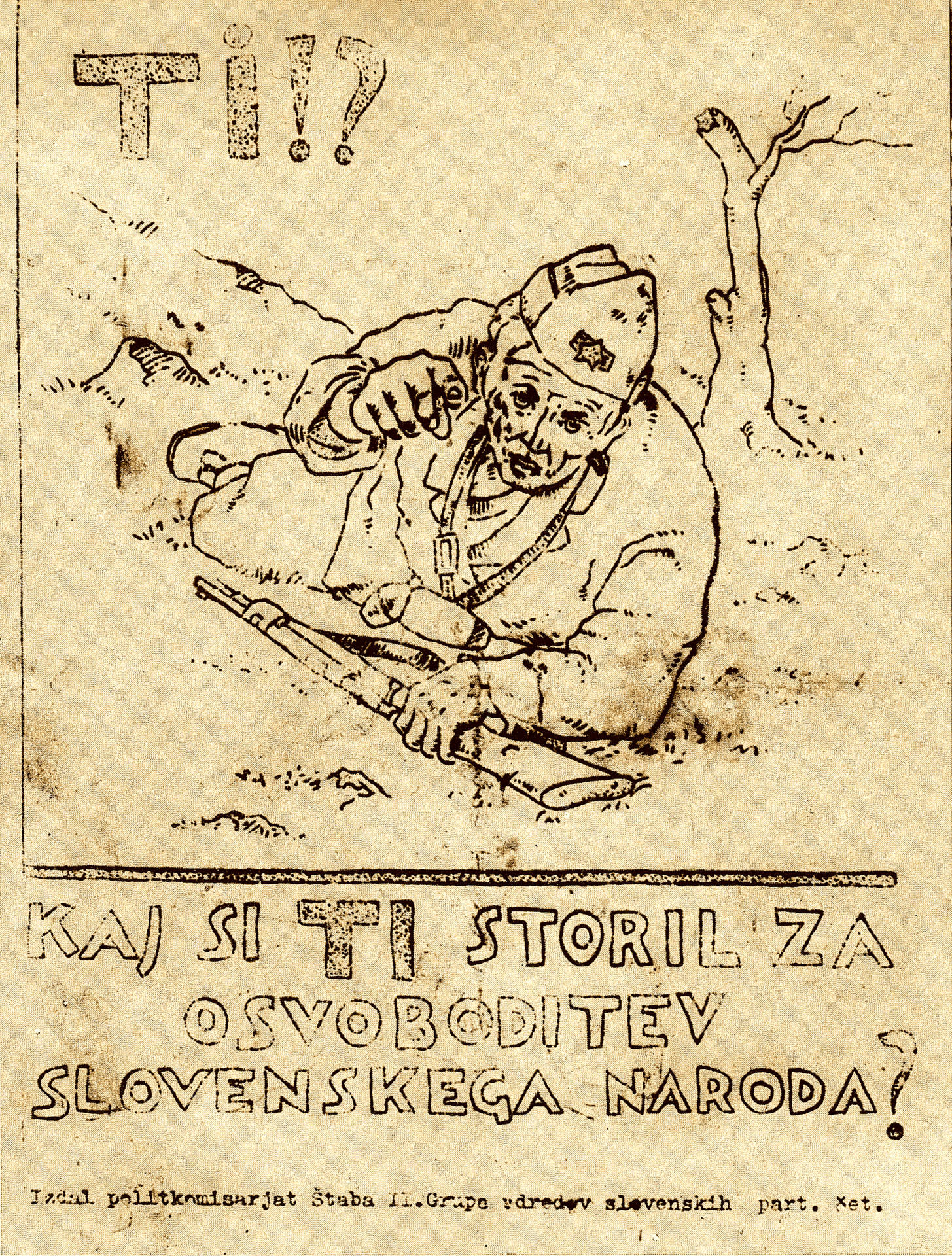1941–1943
The first group of Partisans arrived in the Brkini Hills in September 1941. This was Dolgan’s Company, the first Partisan unit in Primorska, which spread the idea of the Liberation Front and mobilised new fighters. The first Partisan action in Primorska was carried out near Kilovče on 28 October 1941. The Brkini Company was established in April of that same year and continued to carry out actions until the capitulation of Italy. The response of the Italian army to the actions of the resistance fighters was brutal. On 4 June 1942 alone, Italian troops burnt seven villages in the Brkini Hills, the first in the Primorska region, killed 33 people and interned almost 400.
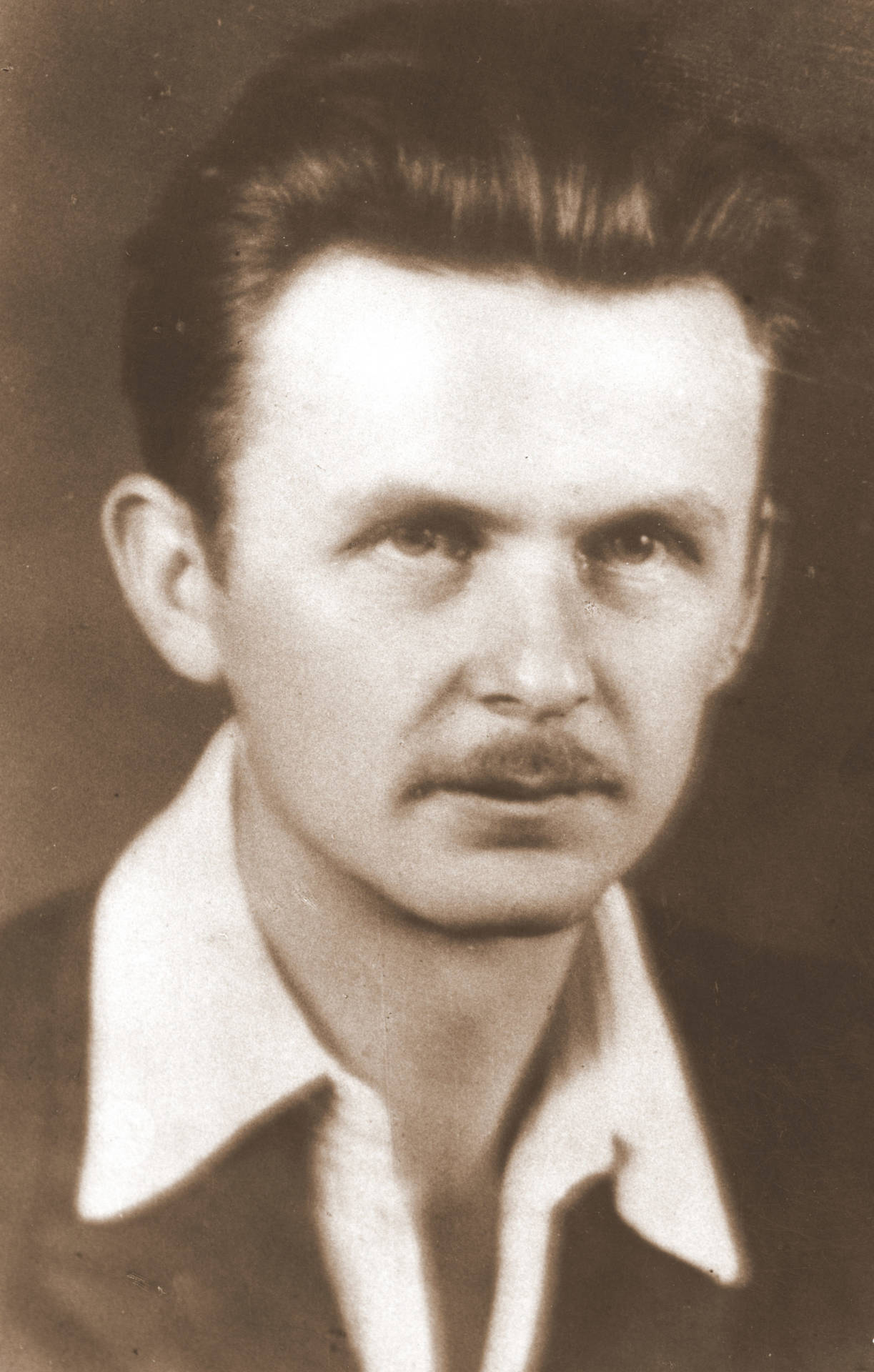 Ervin Dolgan, alias Janez, of Ilirska Bistrica. He first came to the Primorska region as an organiser of the national liberation movement in June 1941. In September of that same year he brought the first eight Partisans to Primorska.
Ervin Dolgan, alias Janez, of Ilirska Bistrica. He first came to the Primorska region as an organiser of the national liberation movement in June 1941. In September of that same year he brought the first eight Partisans to Primorska.
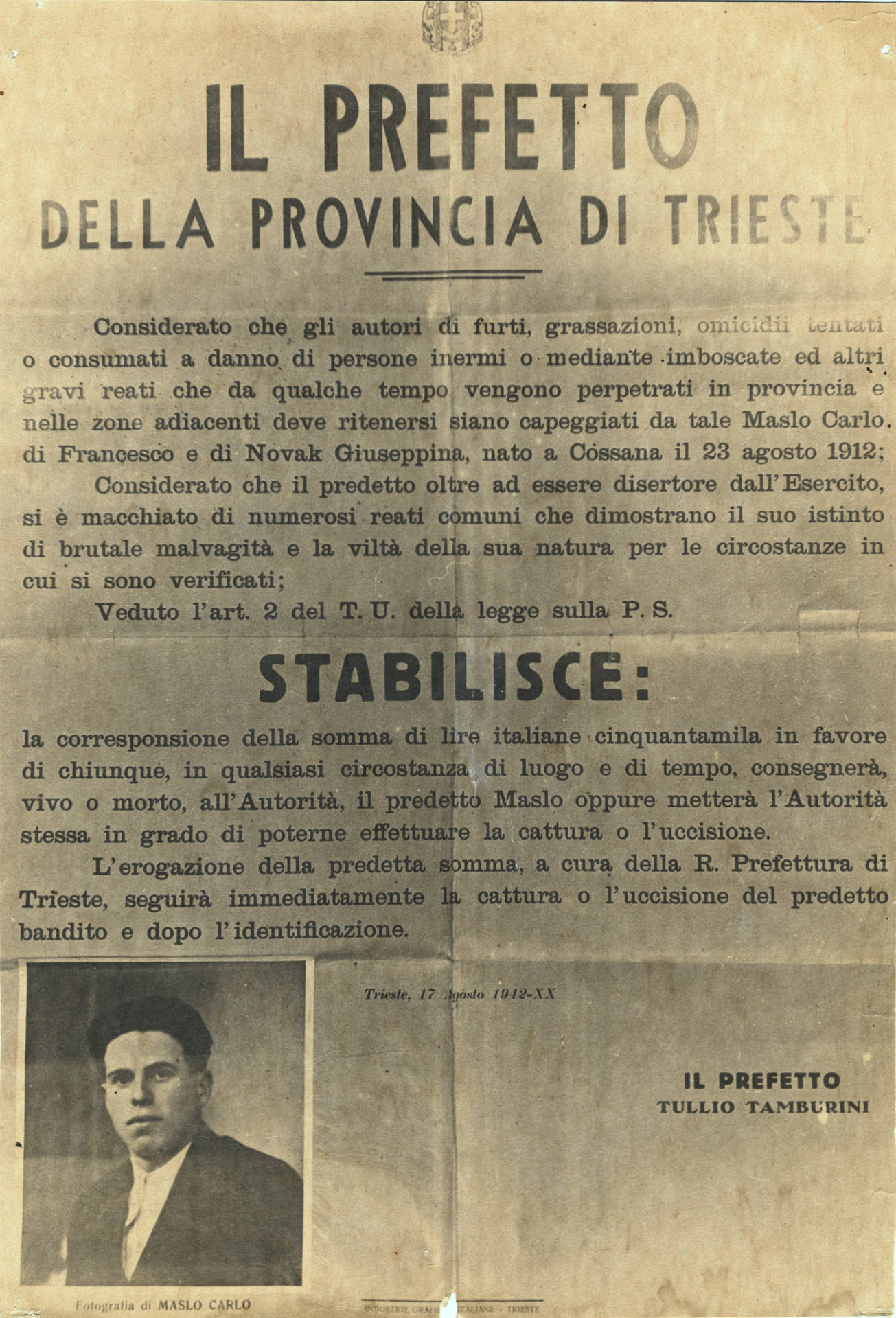 Arrest warrant for Karlo Maslo, commander of the Brkini Company. Originally from Ostrožno Brdo, he led the Brkini Company and was for a time the commander of the Istria Detachment. On 28 October 1941 he and Ervin Dolgan carried out the first commando action in Primorska – the derailment of a German military train near Kilovče.
Arrest warrant for Karlo Maslo, commander of the Brkini Company. Originally from Ostrožno Brdo, he led the Brkini Company and was for a time the commander of the Istria Detachment. On 28 October 1941 he and Ervin Dolgan carried out the first commando action in Primorska – the derailment of a German military train near Kilovče.
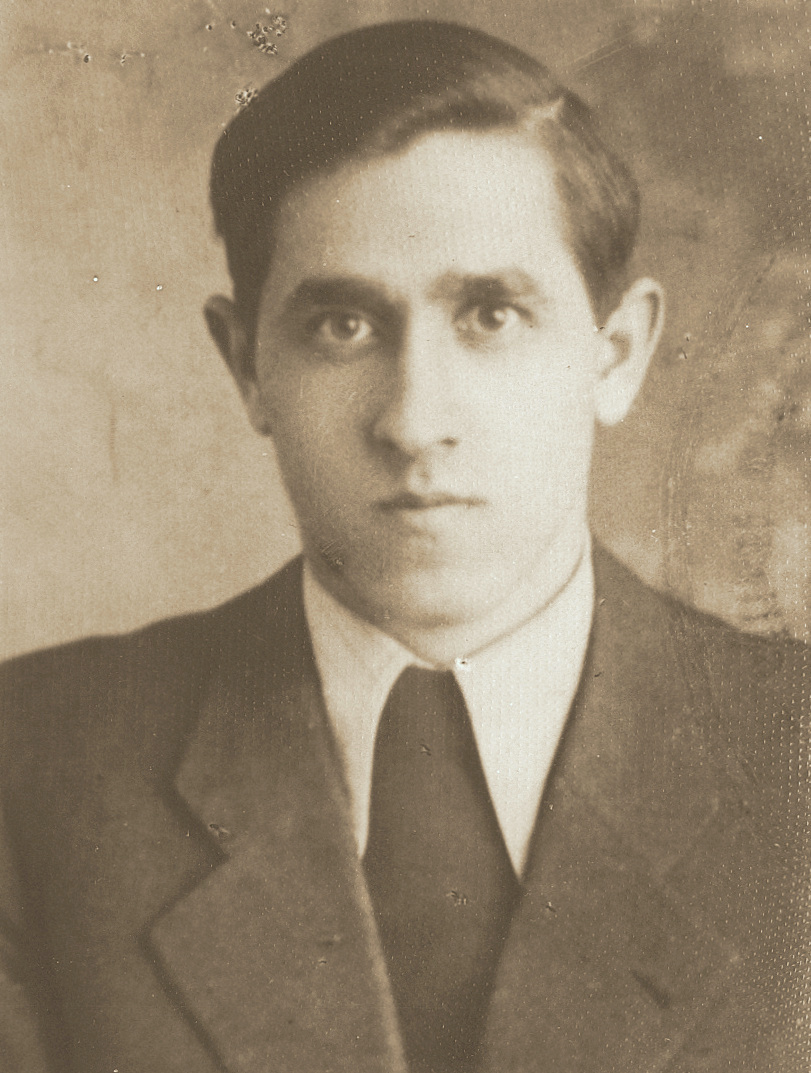 Rudi Mahnič, alias Brkinc, first secretary of the KPS in the Brkini district and later the (larger) Southern Primorska district. He fell in combat in the Slavia Veneta region in November 1943.
Rudi Mahnič, alias Brkinc, first secretary of the KPS in the Brkini district and later the (larger) Southern Primorska district. He fell in combat in the Slavia Veneta region in November 1943.
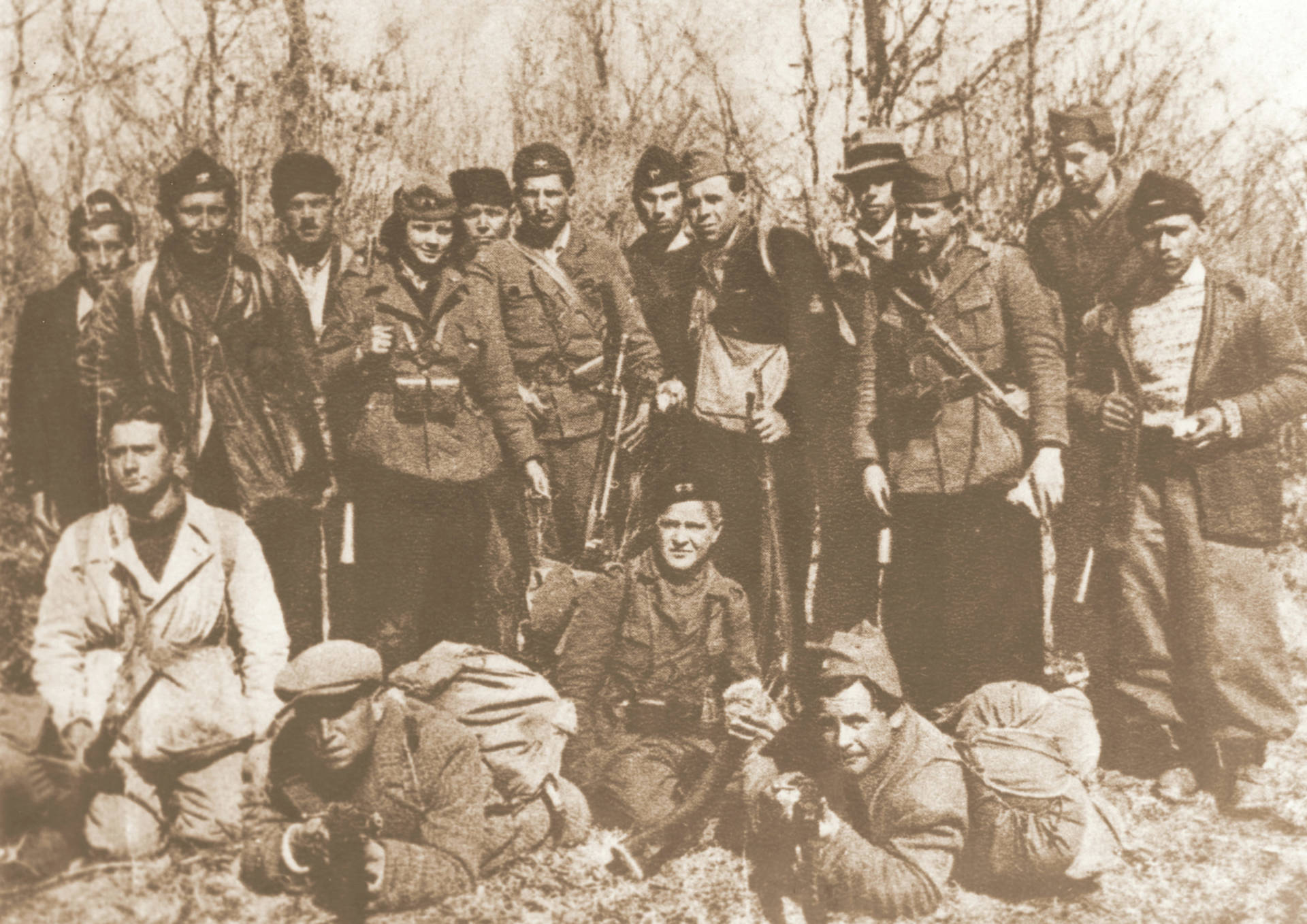 Fighters of the Pivka Company, including Karlo Maslo and Franc Segulin, alias Boro Kladivar.
Fighters of the Pivka Company, including Karlo Maslo and Franc Segulin, alias Boro Kladivar.
 Fighters of the Brkini Company in 1943. In the first period, the Partisans also spread the idea of the Liberation Front through villages, organised people for collaboration and were themselves Liberation Front activists.
Fighters of the Brkini Company in 1943. In the first period, the Partisans also spread the idea of the Liberation Front through villages, organised people for collaboration and were themselves Liberation Front activists.
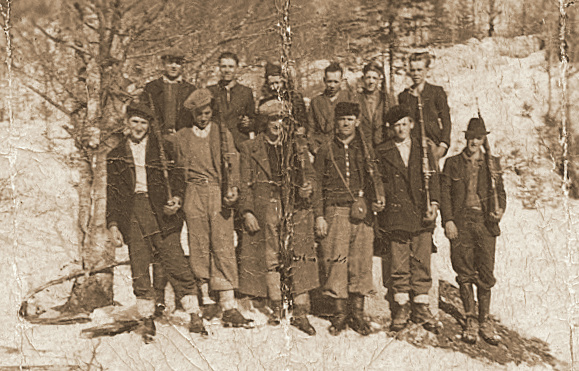 Young men from the Brkini area setting off to join the Partisans in February 1943. In this way they avoided being conscripted into the Italian army.
Young men from the Brkini area setting off to join the Partisans in February 1943. In this way they avoided being conscripted into the Italian army.
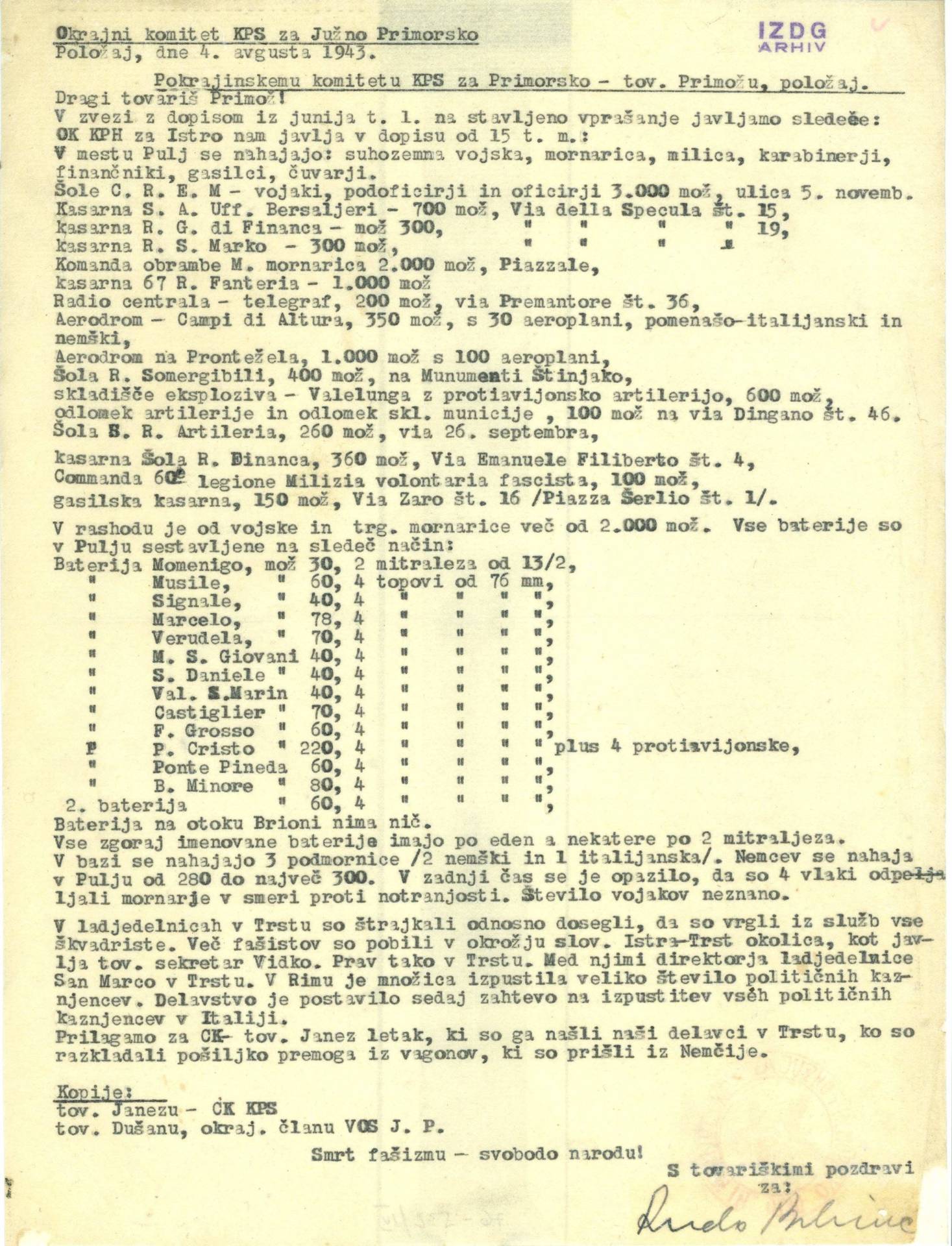
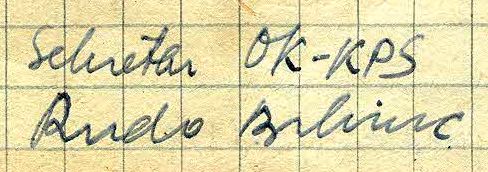
National Liberation Movement
The Italian capitulation on 8 September 1943 triggered a general popular insurrection in Primorska: mass demonstrations, the disarming of the Italian army, the liberation of prisoners, the establishment of popular power (in the form of the National Liberation Council for Primorska as the central authority in the region) and a general mobilisation. New Partisan units were formed: the Slovene-Croatian Istria Detachment, the Snežnik or Brkini Brigade, the 1st Slovene Istria Brigade and the Trieste Brigade. On 16 September the Liberation Front executive committee issued a proclamation on the incorporation of Primorska into Yugoslavia. Deputies from the region were sent to a session of the Assembly of Deputies of the Slovene People in Kočevje.
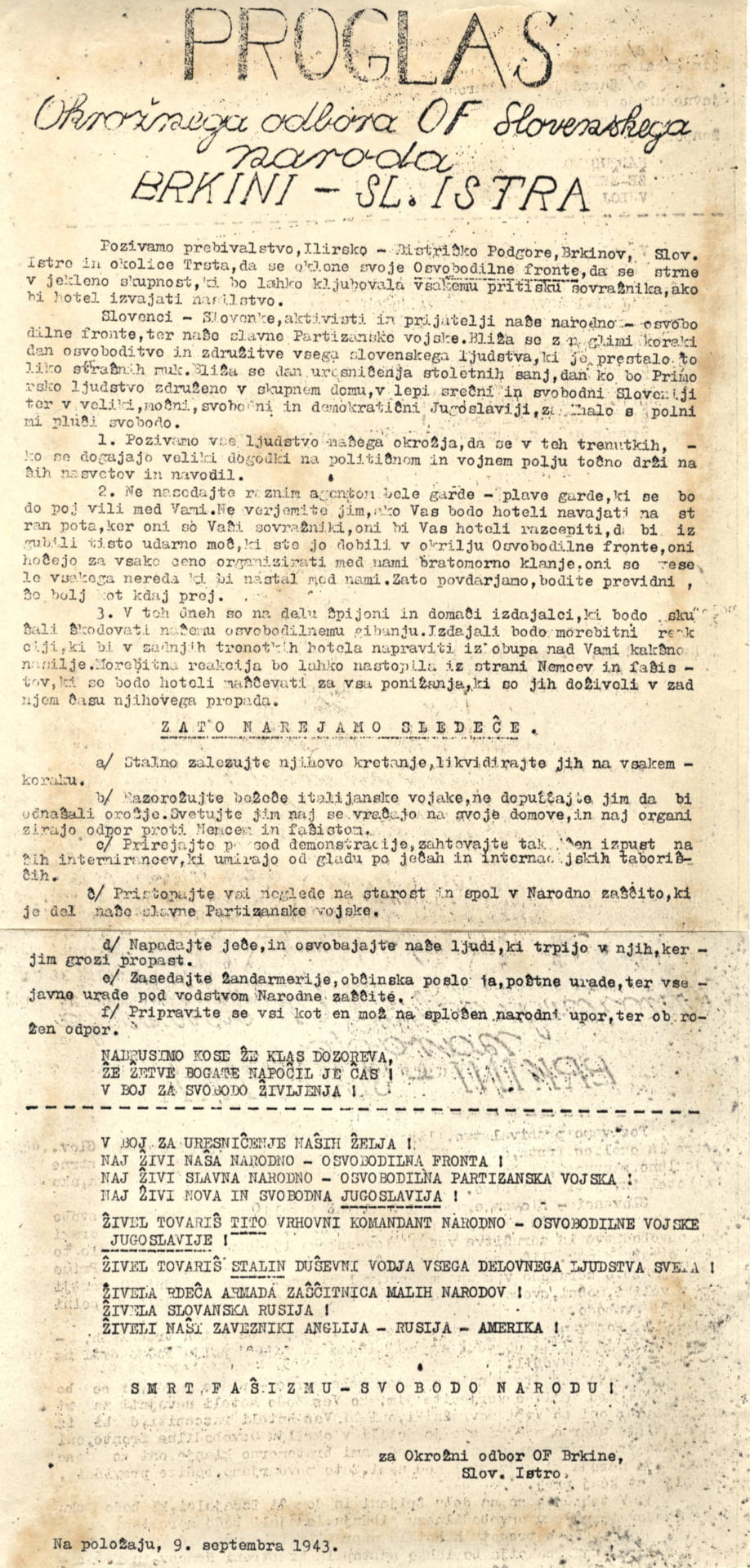
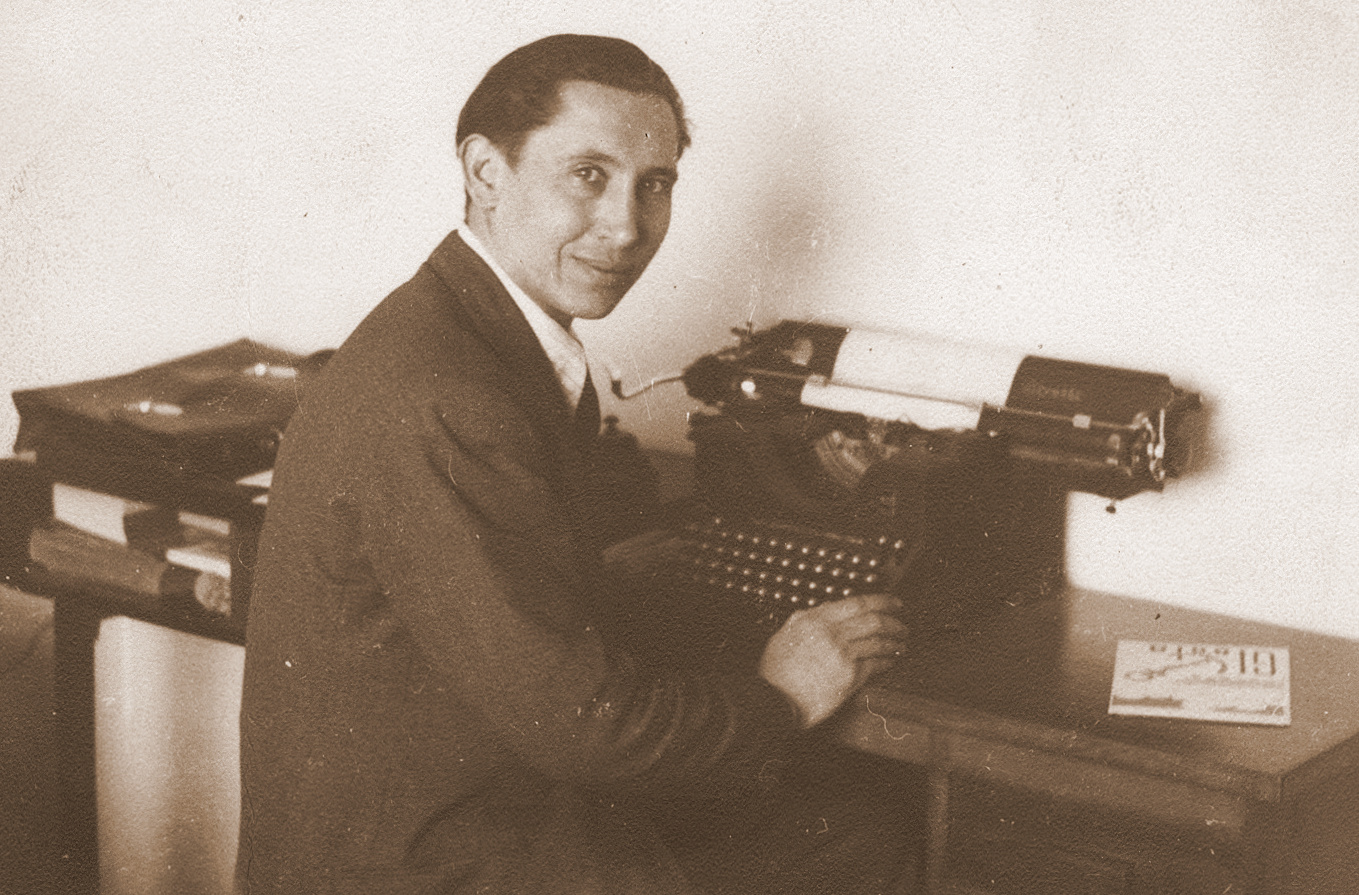 Franc Segulin, alias Boro Kladivar, of Materija, was the leader of the combined Brkini–Slovene Istria district at the time of the Italian capitulation. Arrested in Trieste, where he had been sent as secretary of the Communist Party, he died in the Risiera di San Sabba.
Franc Segulin, alias Boro Kladivar, of Materija, was the leader of the combined Brkini–Slovene Istria district at the time of the Italian capitulation. Arrested in Trieste, where he had been sent as secretary of the Communist Party, he died in the Risiera di San Sabba.
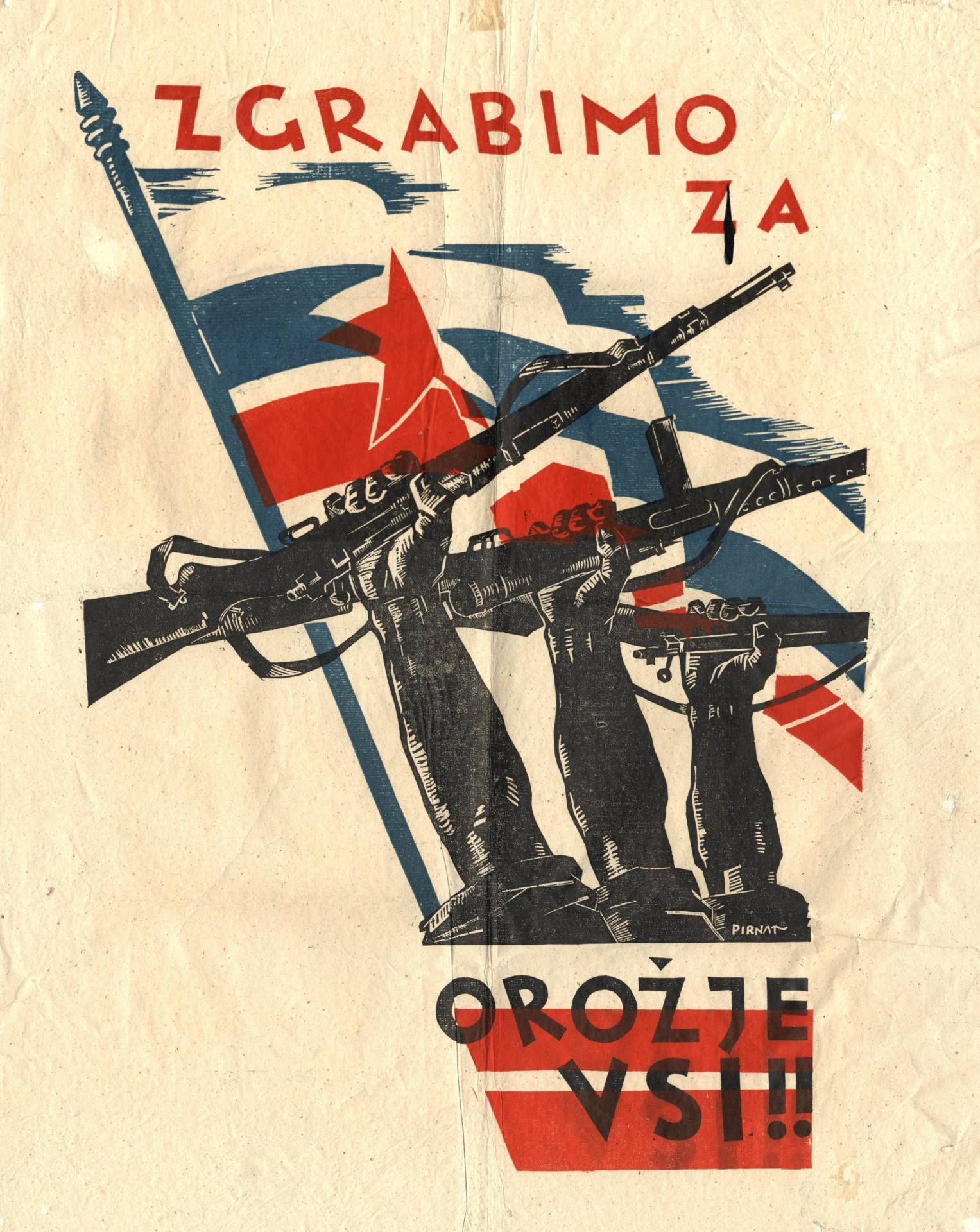
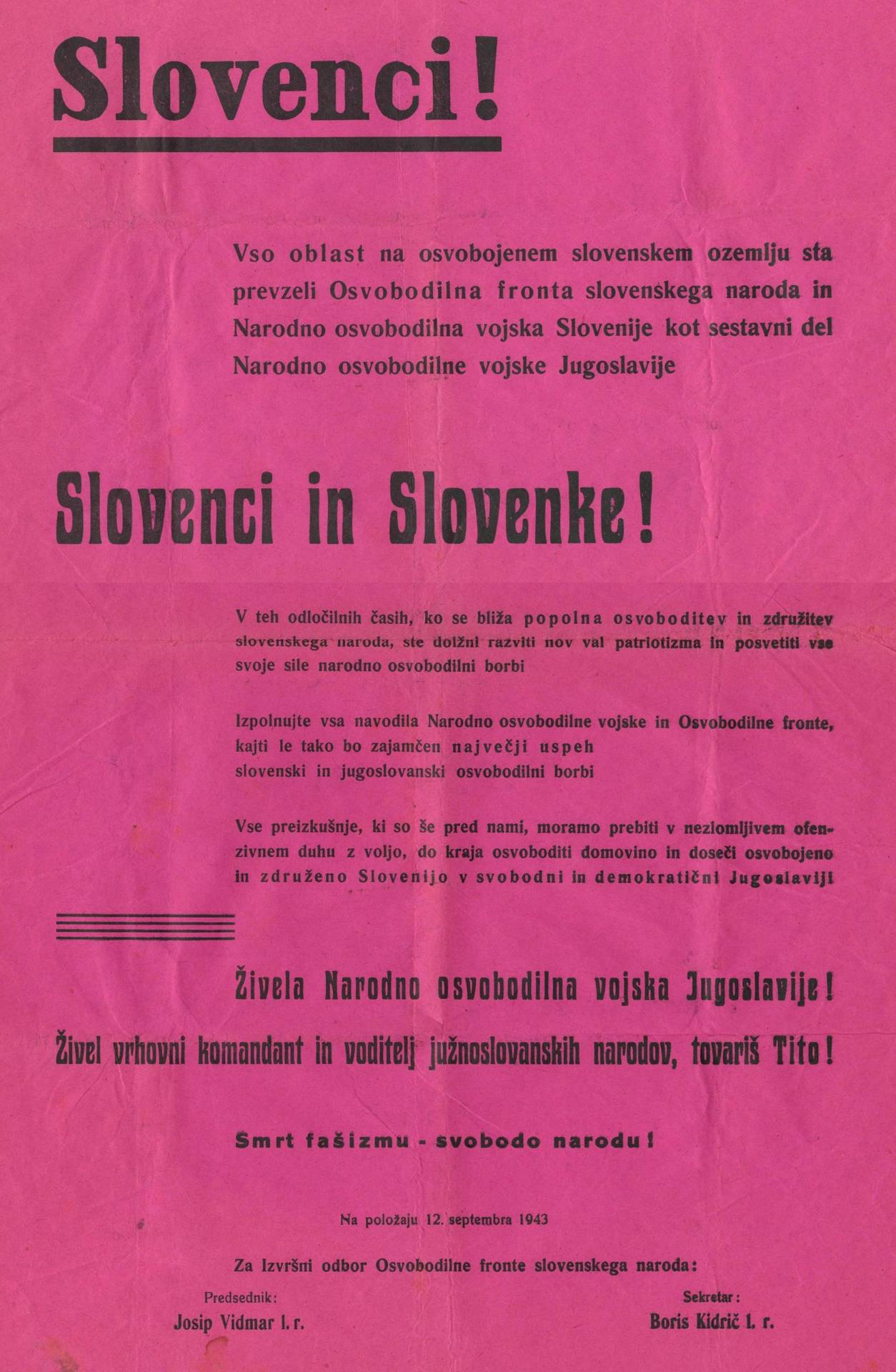
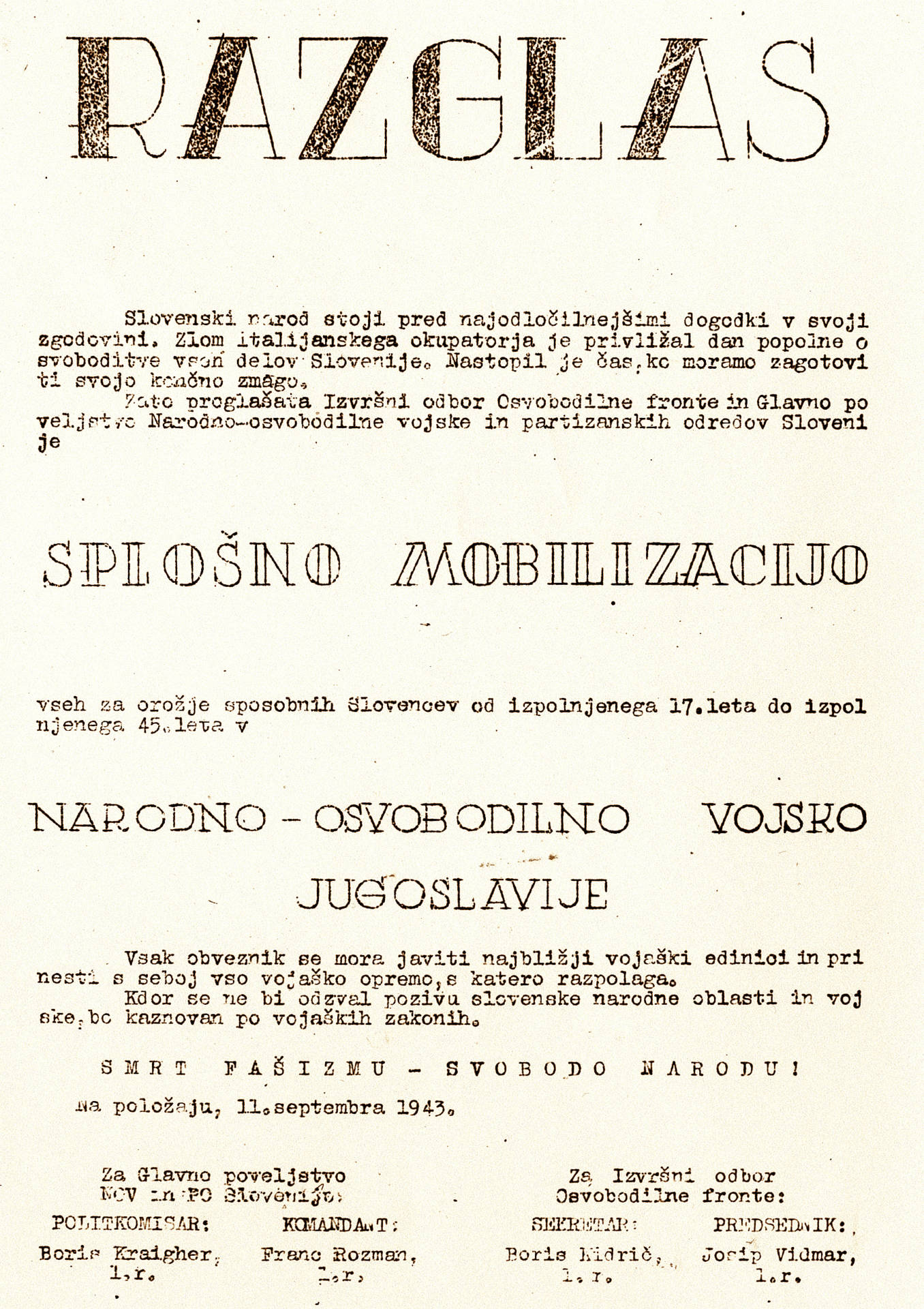
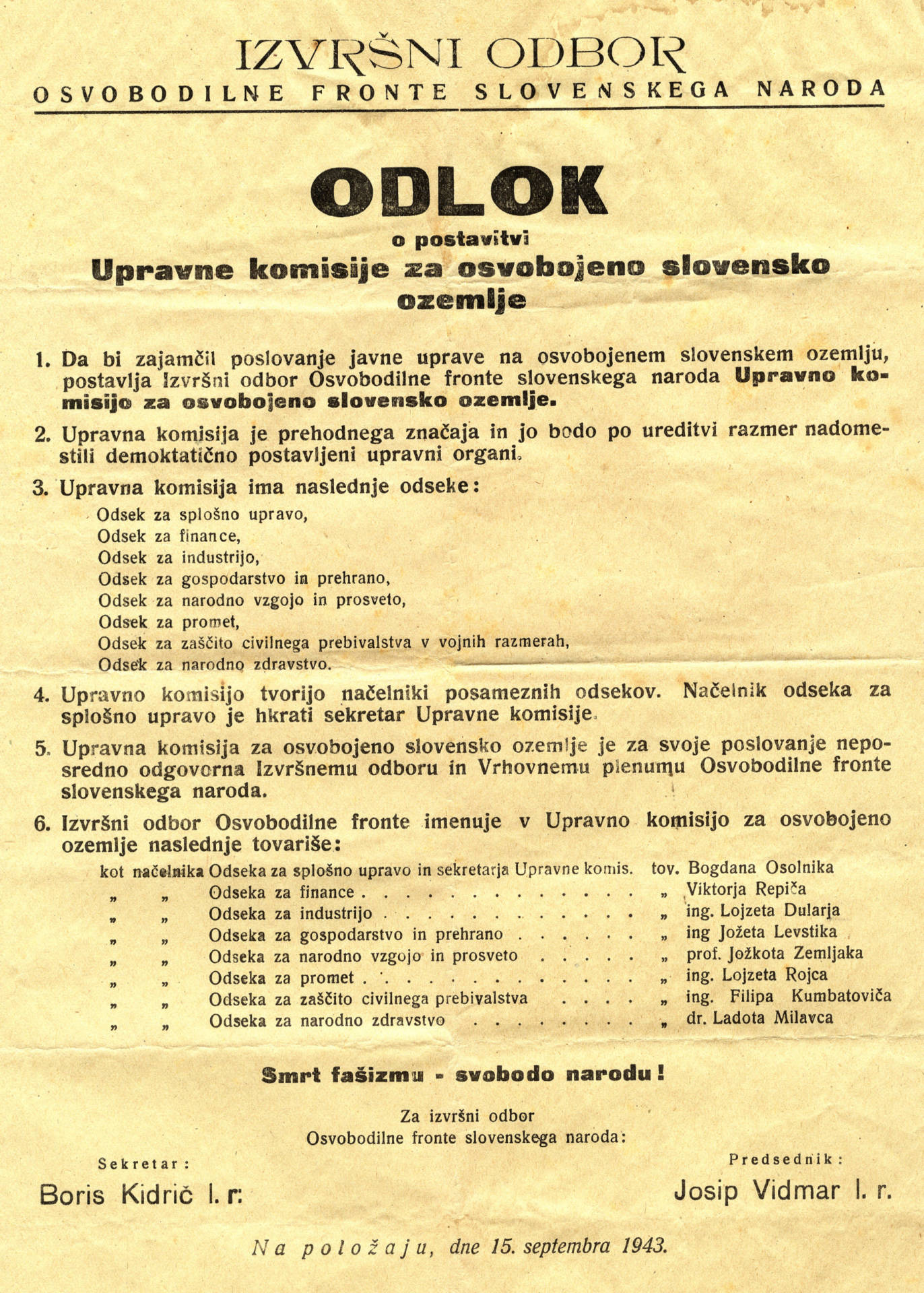
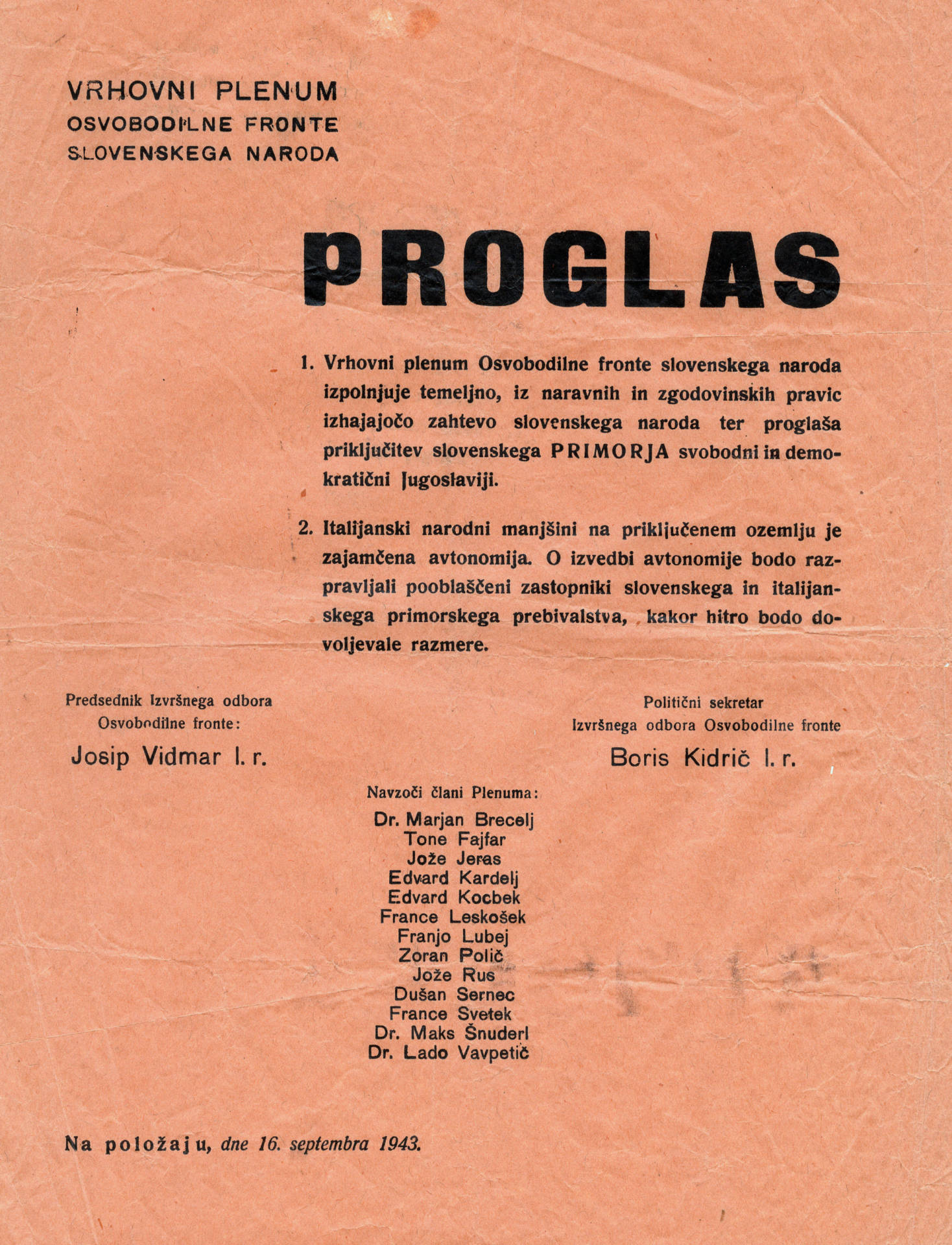
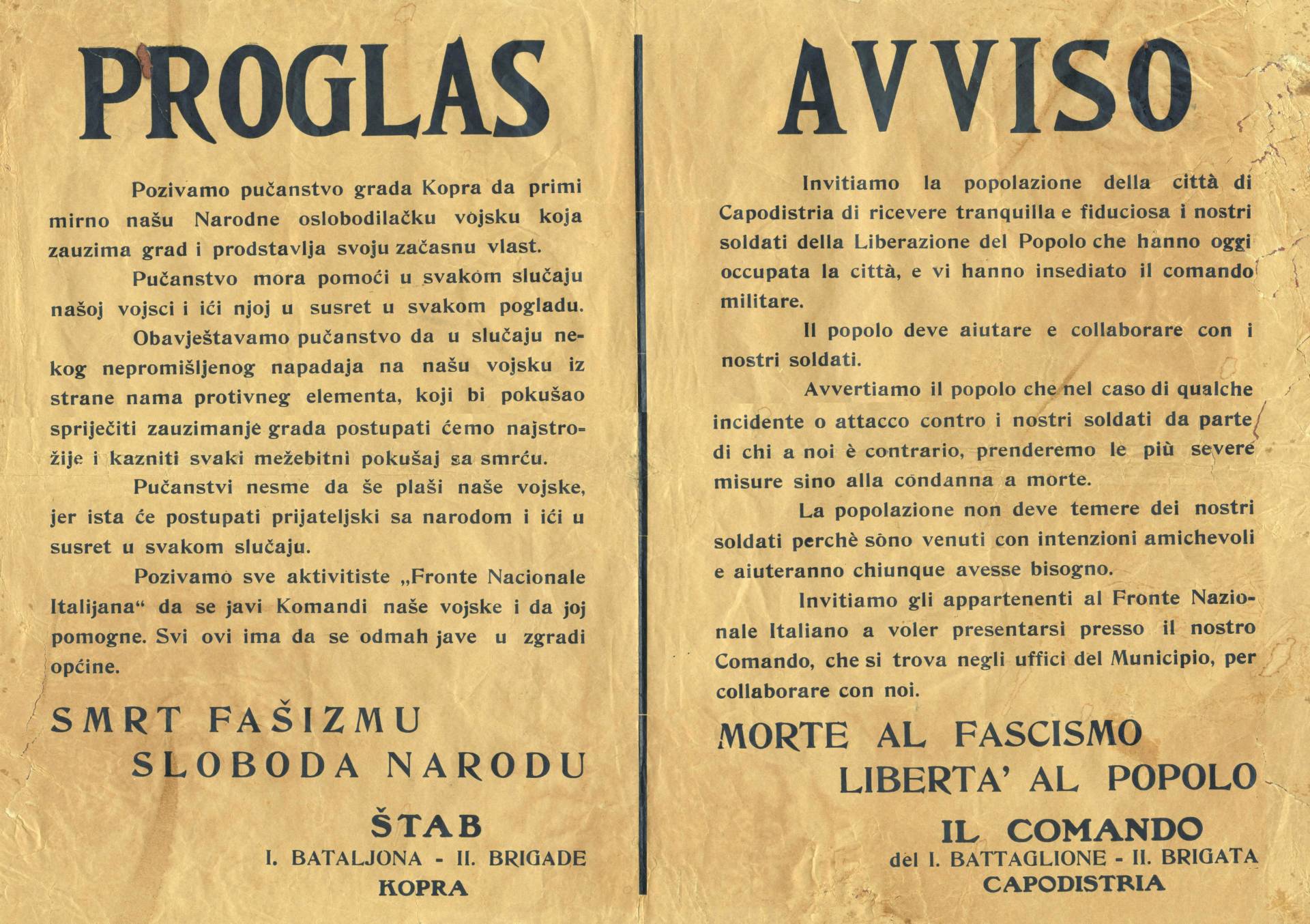
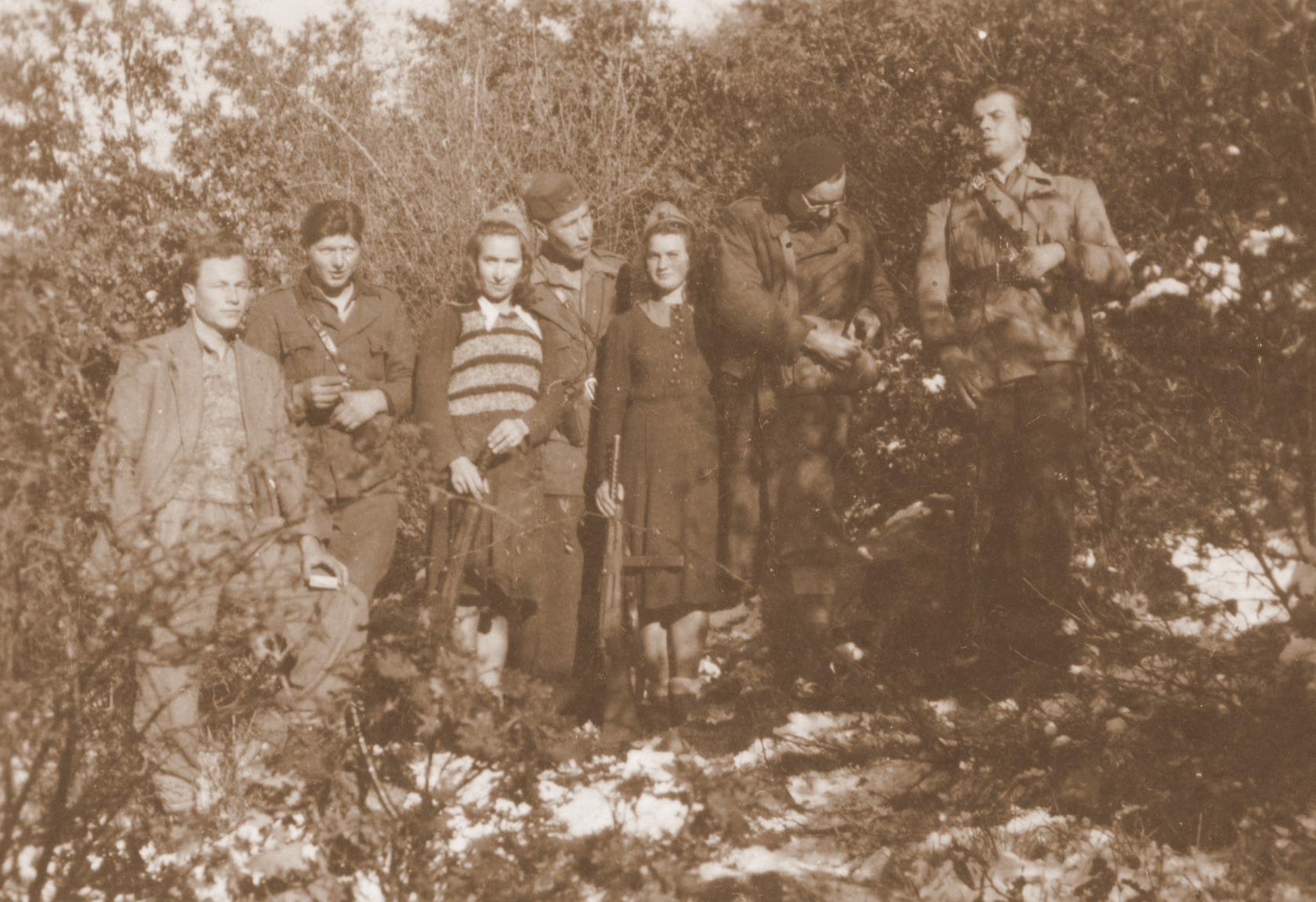 Fighters of the 1st Slovene Istria Brigade, including their commander Ivan Kovačič, alias Efenka, and commissar Dragomir Benčič, alias Brkin.
Fighters of the 1st Slovene Istria Brigade, including their commander Ivan Kovačič, alias Efenka, and commissar Dragomir Benčič, alias Brkin.
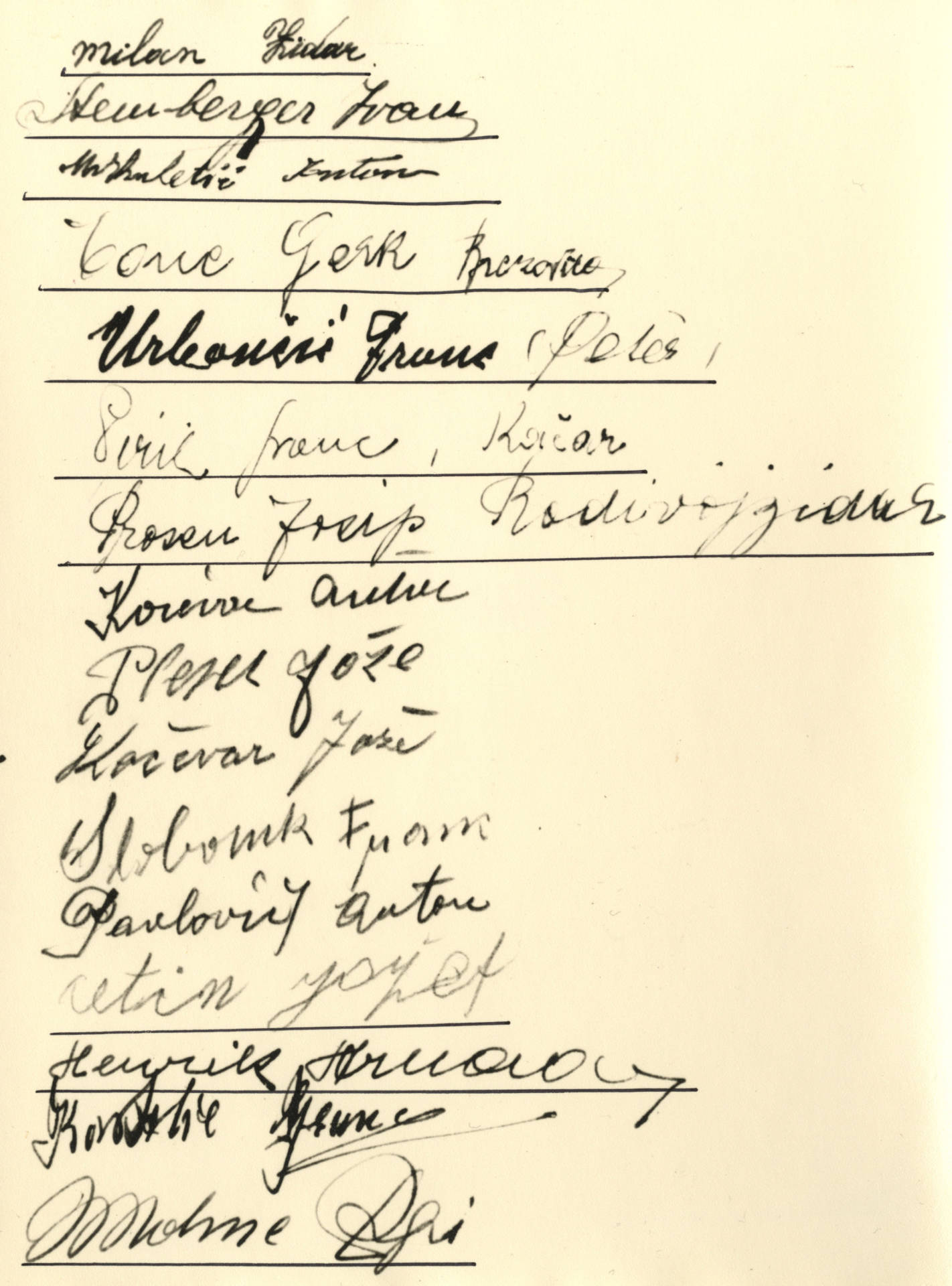 Delegates from Slovene Istria and the Brkini Hills signed the commemorative book at the Kočevje assembly.
Delegates from Slovene Istria and the Brkini Hills signed the commemorative book at the Kočevje assembly.
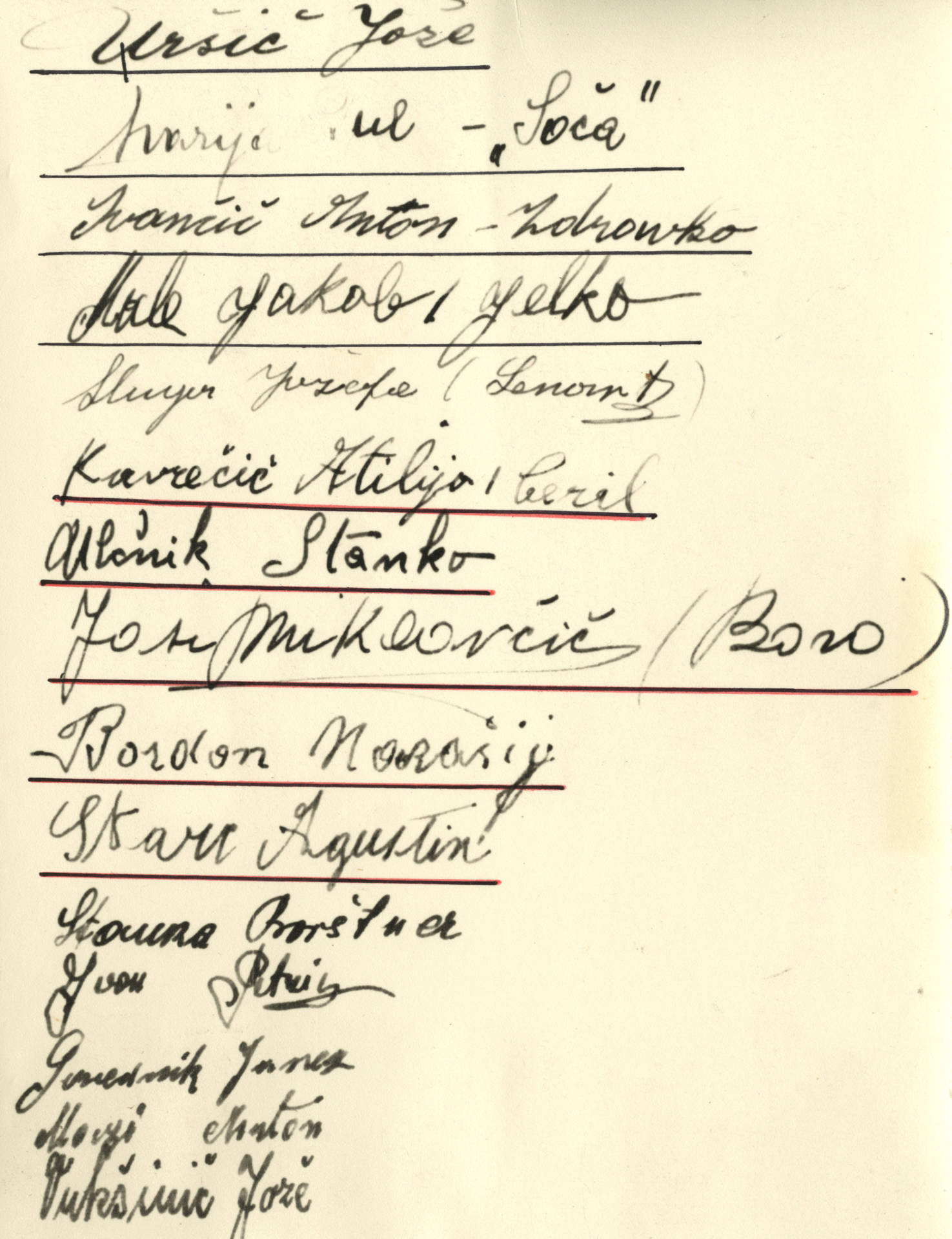 Delegates from Slovene Istria and the Brkini Hills signed the commemorative book at the Kočevje assembly.
Delegates from Slovene Istria and the Brkini Hills signed the commemorative book at the Kočevje assembly.
1943 – 1945
The course of the insurrection was temporarily halted by the Germans’ October offensive, but the leaders of the national liberation movement wasted no time in renewing and improving their organisation. By September 1944 conditions for development and work were very favourable and activities flourished in numerous fields – Partisan schools, propaganda, healthcare, economic activity, and so on. The youth organisation and women’s organisation (ZMS and SPŽZ) were particularly active. Elections were held in the summer and autumn of 1944, following an administrative reorganisation, and in October 1944 the first leadership of the Southern Primorska district was elected. Further new Partisan units were established. The work of the national liberation movement became more difficult in the autumn of 1944 and the winter of 1944–45, particularly in Slovene Istria, as a result of the fortification of the area by the enemy in anticipation of an Allied landing in Istria. A new surge of activity in the spring of 1945 culminated in the liberation of 1 May 1945 and the seizing of power in towns and cities.
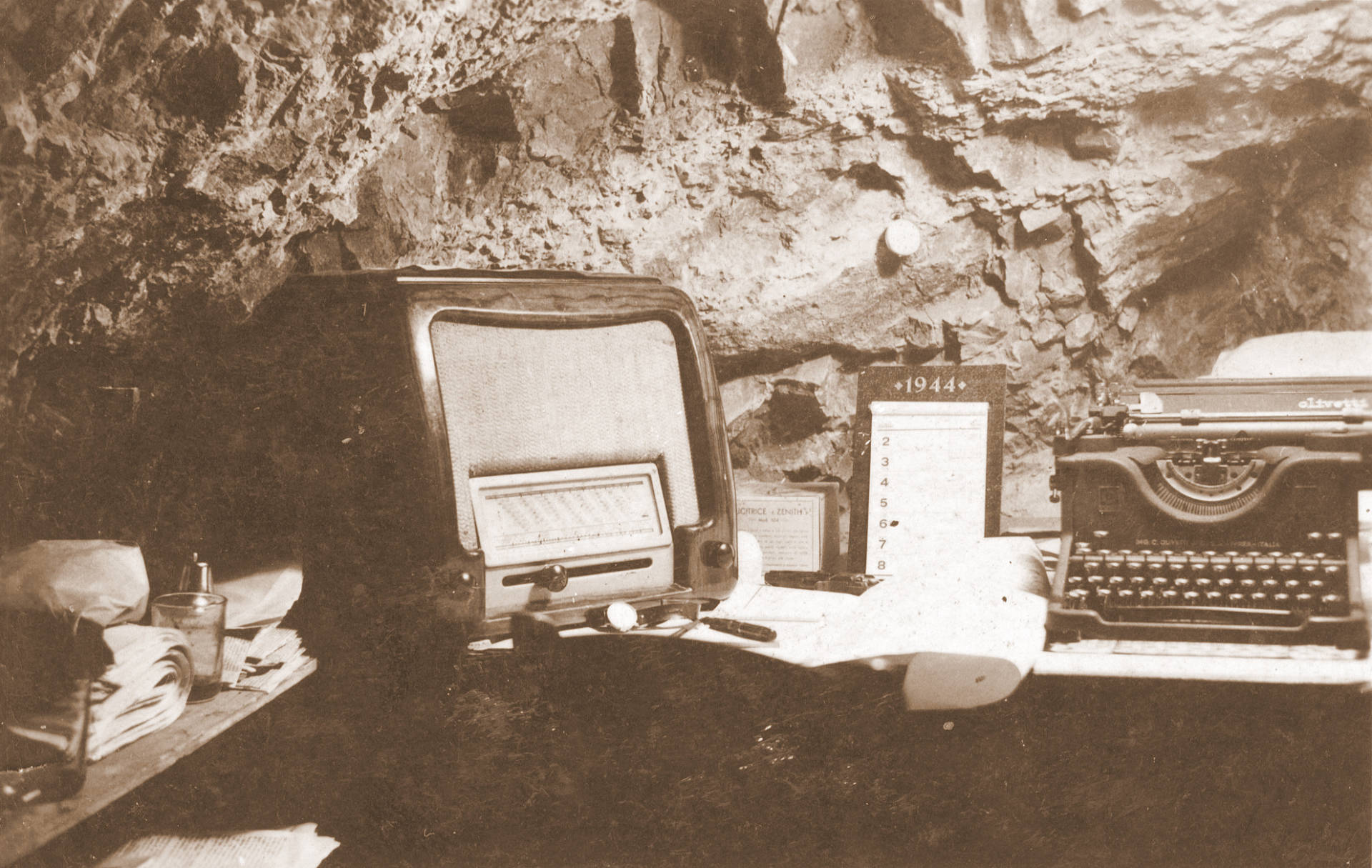 Bunker in Avguštin Hrovatin’s house in Badiha, created for the use of the leadership of the Slovene Istria district.
Bunker in Avguštin Hrovatin’s house in Badiha, created for the use of the leadership of the Slovene Istria district.
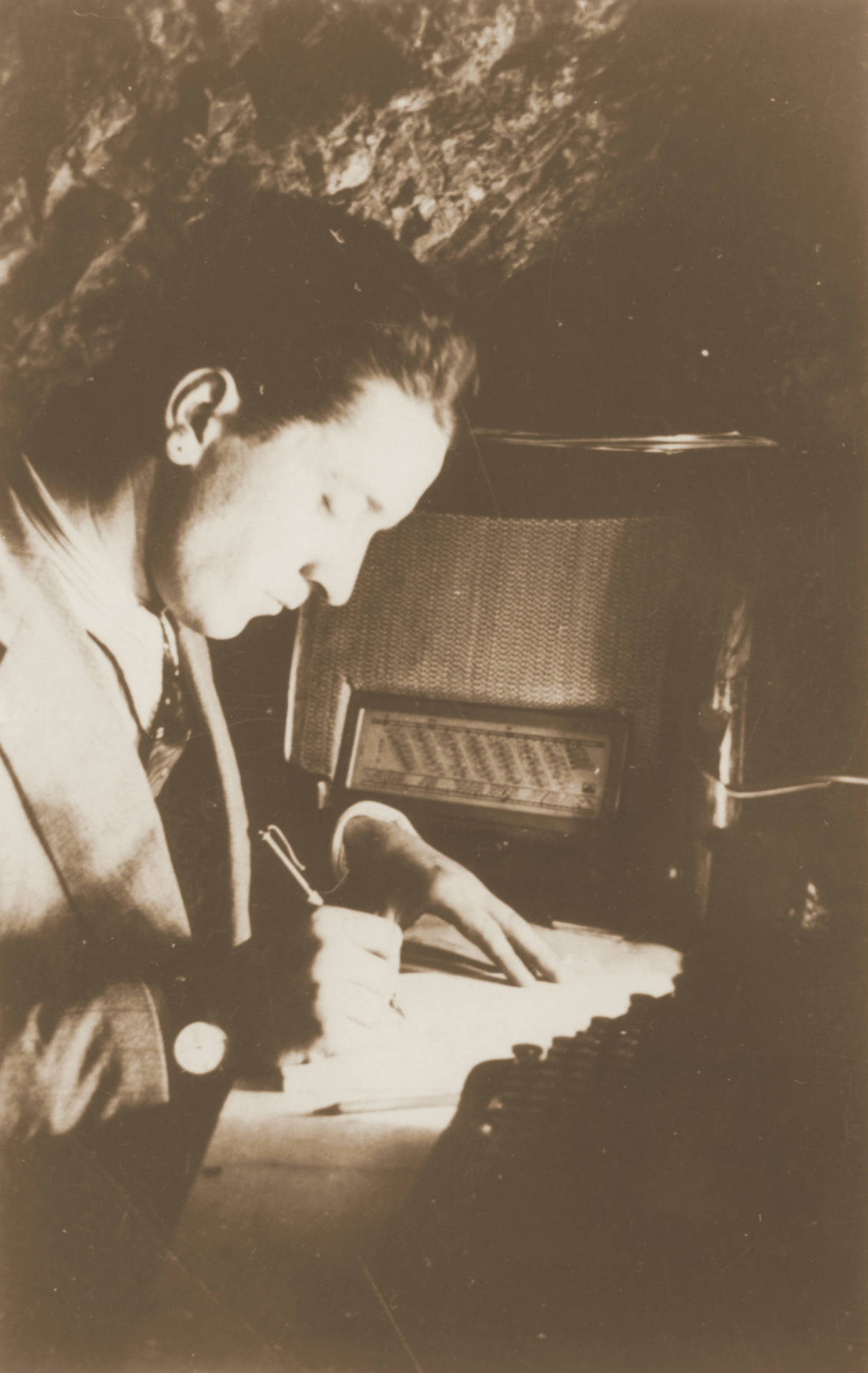 Milan Guček, alias Javor, secretary of the Liberation Front committee for the Slovene Istria district in the bunker in Badiha.
Milan Guček, alias Javor, secretary of the Liberation Front committee for the Slovene Istria district in the bunker in Badiha.
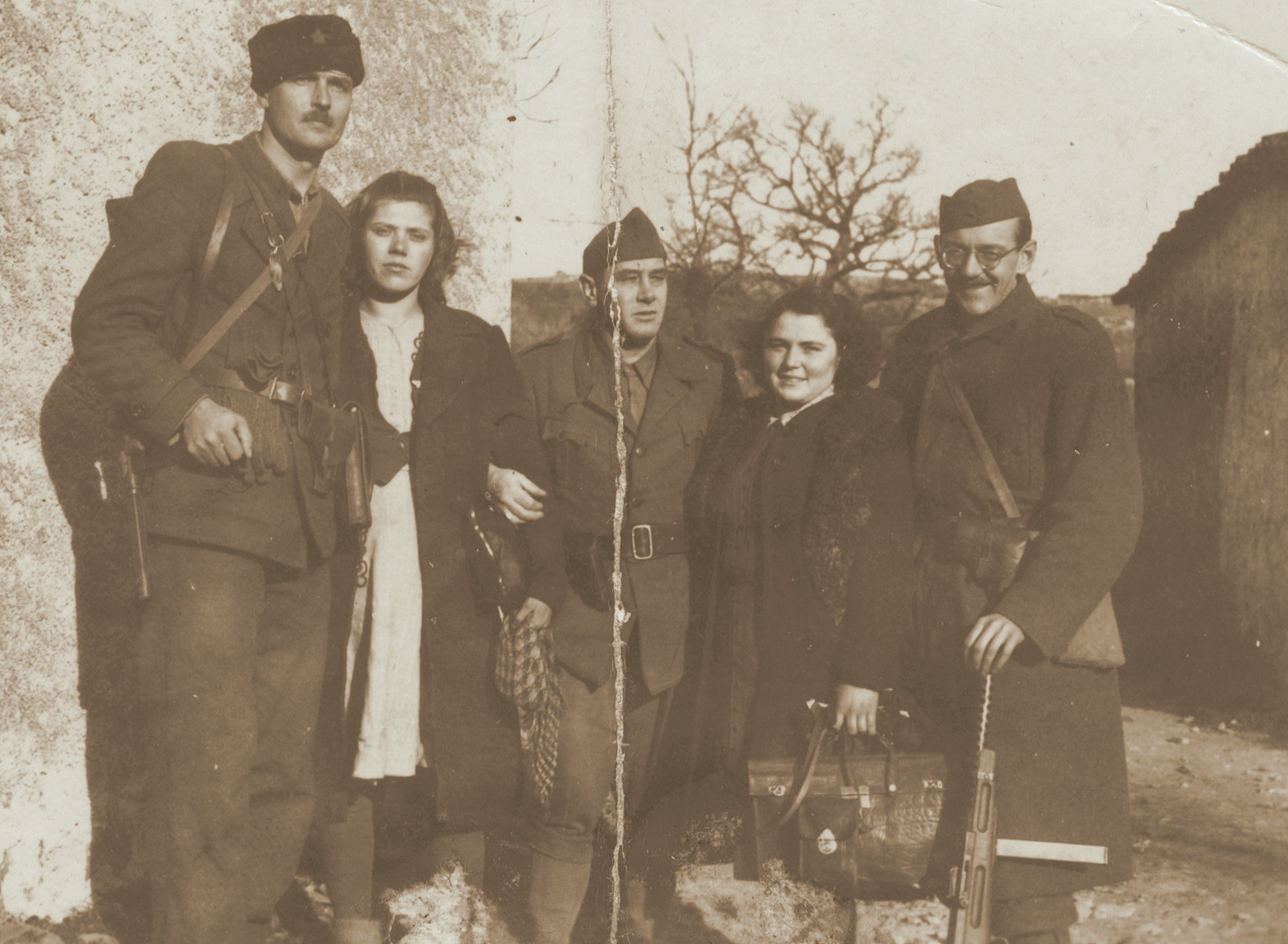 Members of the leadership of the Slovene Istria district and the Snežnik clandestine printing shop in Badiha on 1 January 1944. Stanko Pervanje, alias Gruden, secretary of the district committee of the KPS, is standing on the left.
Members of the leadership of the Slovene Istria district and the Snežnik clandestine printing shop in Badiha on 1 January 1944. Stanko Pervanje, alias Gruden, secretary of the district committee of the KPS, is standing on the left.
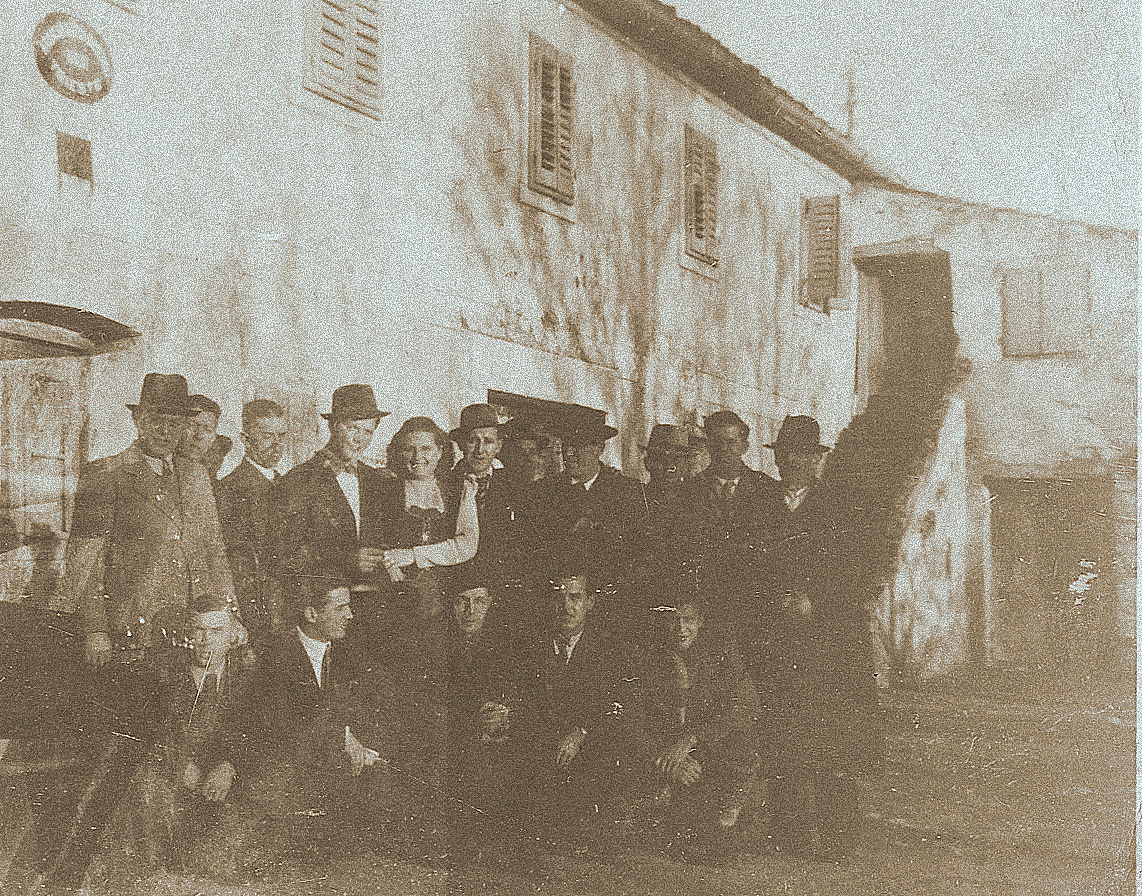 Hrpelje, November 1943. Activists in front of the house of activist Marija Tul, alias Soča.
Hrpelje, November 1943. Activists in front of the house of activist Marija Tul, alias Soča.
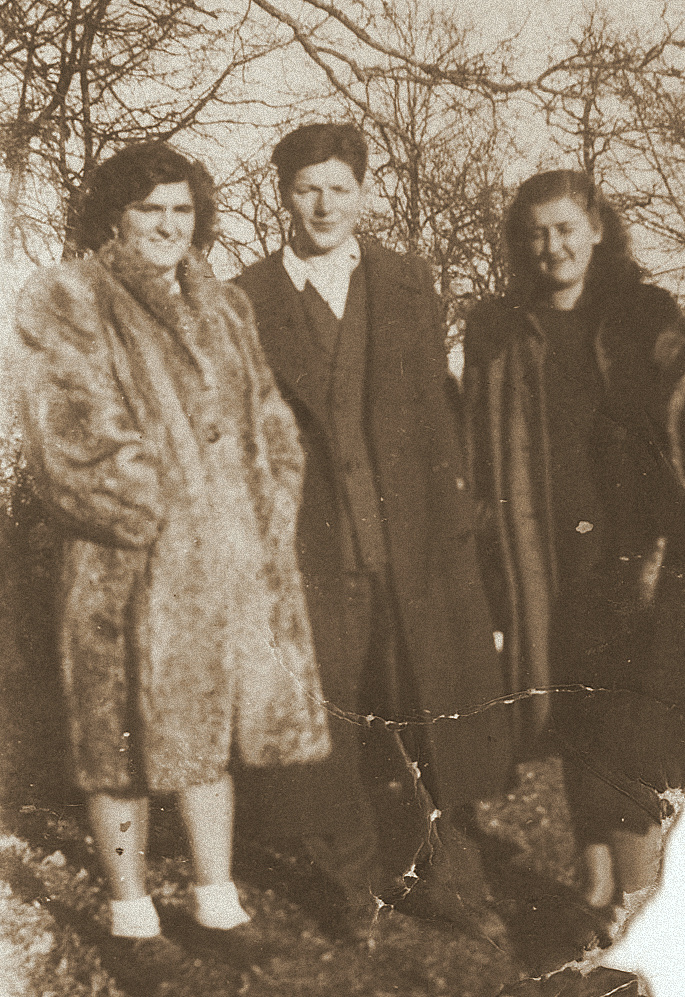 Kozina, October 1943 – young activists.
Kozina, October 1943 – young activists.
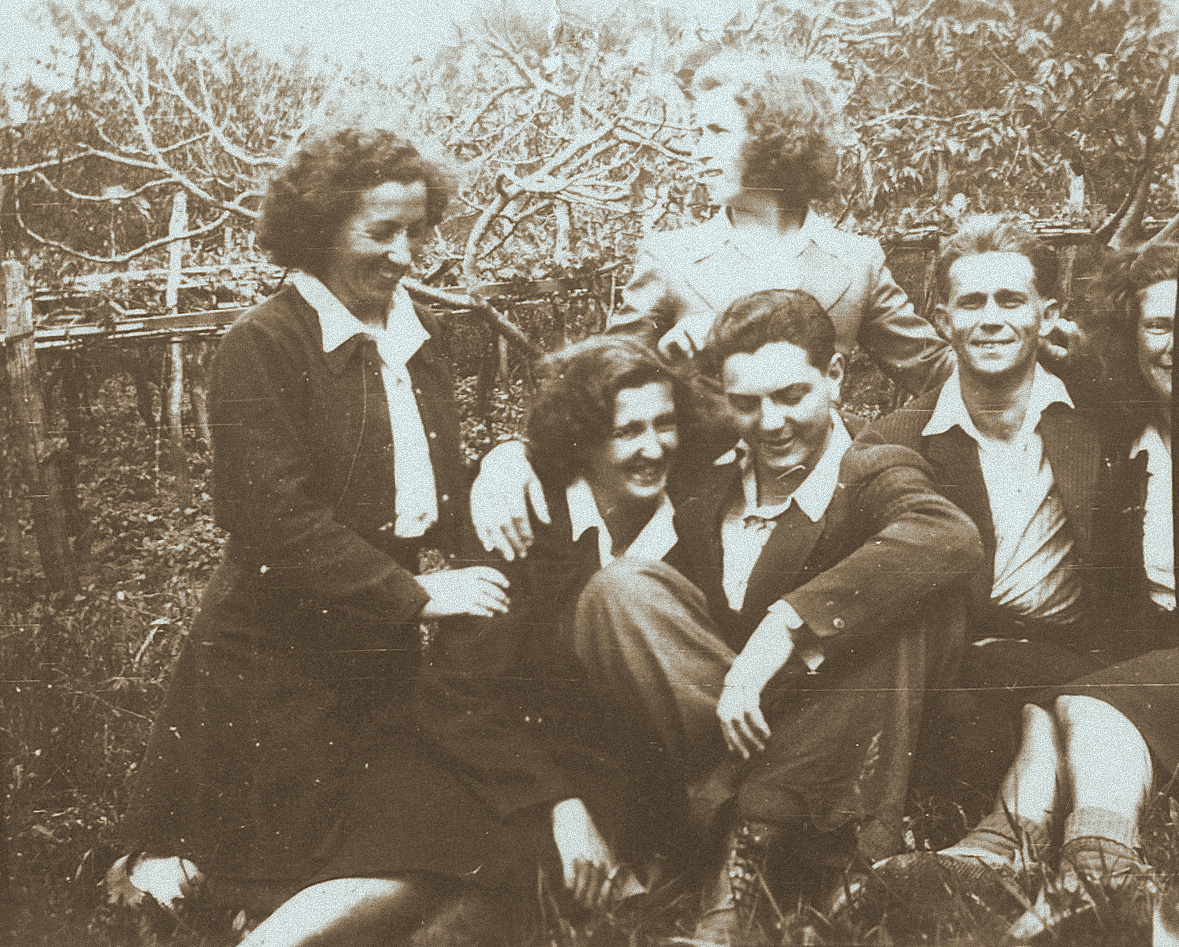 Members of the leadership of the Youth League of Slovenia (ZMS) and the League of Communist Youth of Yugoslavia (SKOJ) in the Slovene Istria district in spring 1944.
Members of the leadership of the Youth League of Slovenia (ZMS) and the League of Communist Youth of Yugoslavia (SKOJ) in the Slovene Istria district in spring 1944.
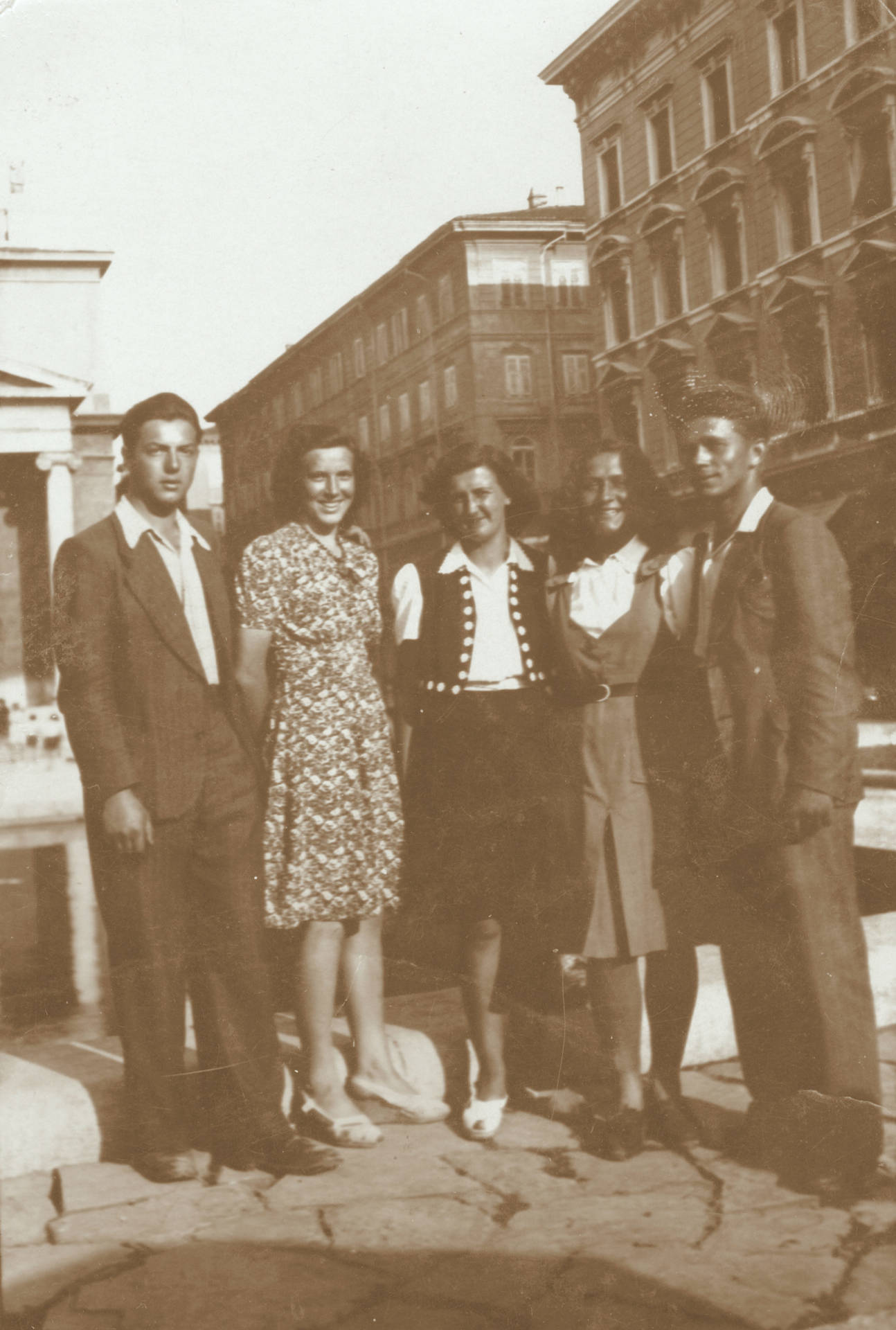 Members of the Istrian district youth leadership in Trieste in spring 1944.
Members of the Istrian district youth leadership in Trieste in spring 1944.
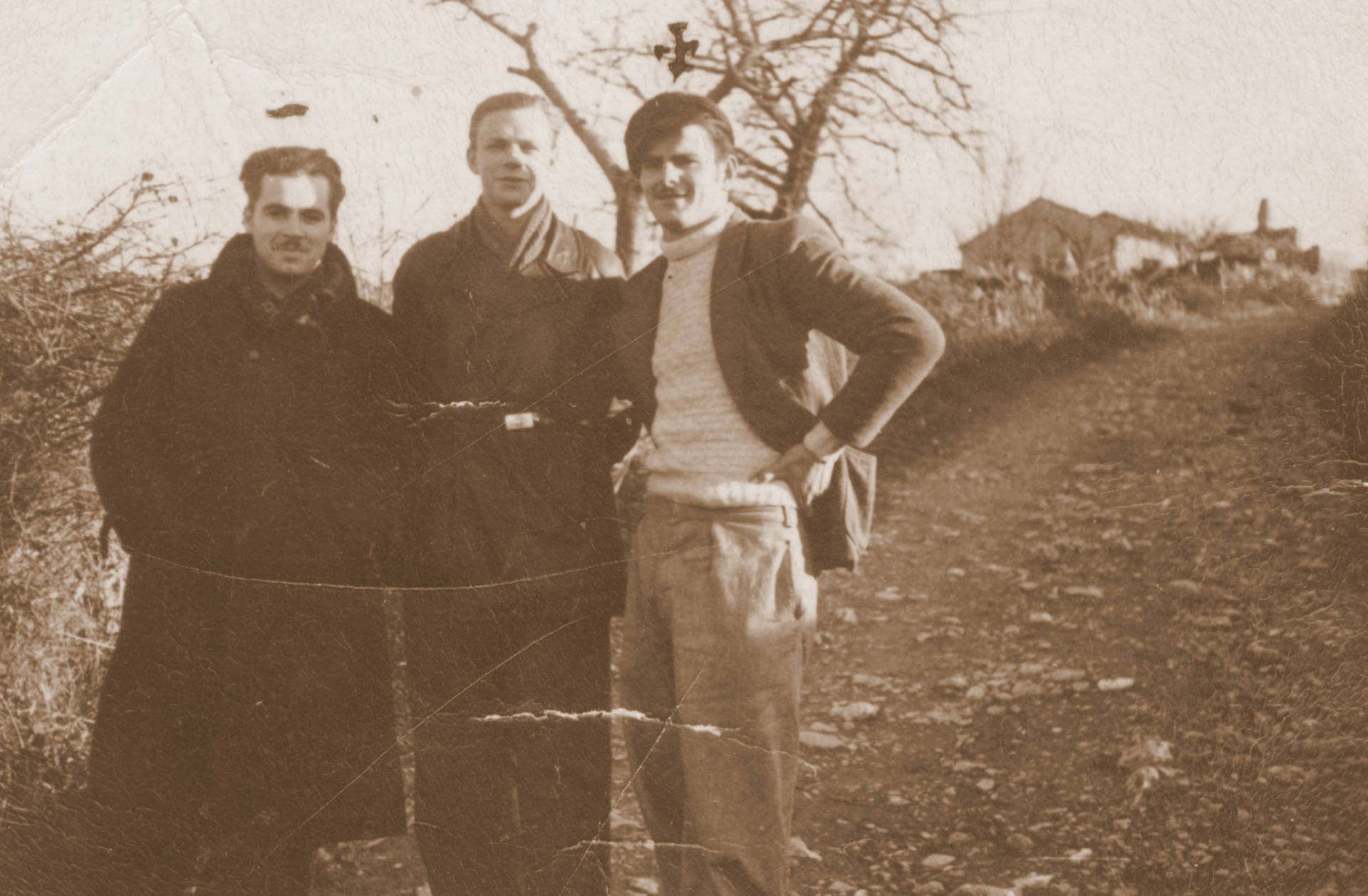 Istrian activists Josip Miklavčič, alias Boros and Mirko Markežič, alias Bus and Karlo Božič, a member of the Koper City Command.
Istrian activists Josip Miklavčič, alias Boros and Mirko Markežič, alias Bus and Karlo Božič, a member of the Koper City Command.
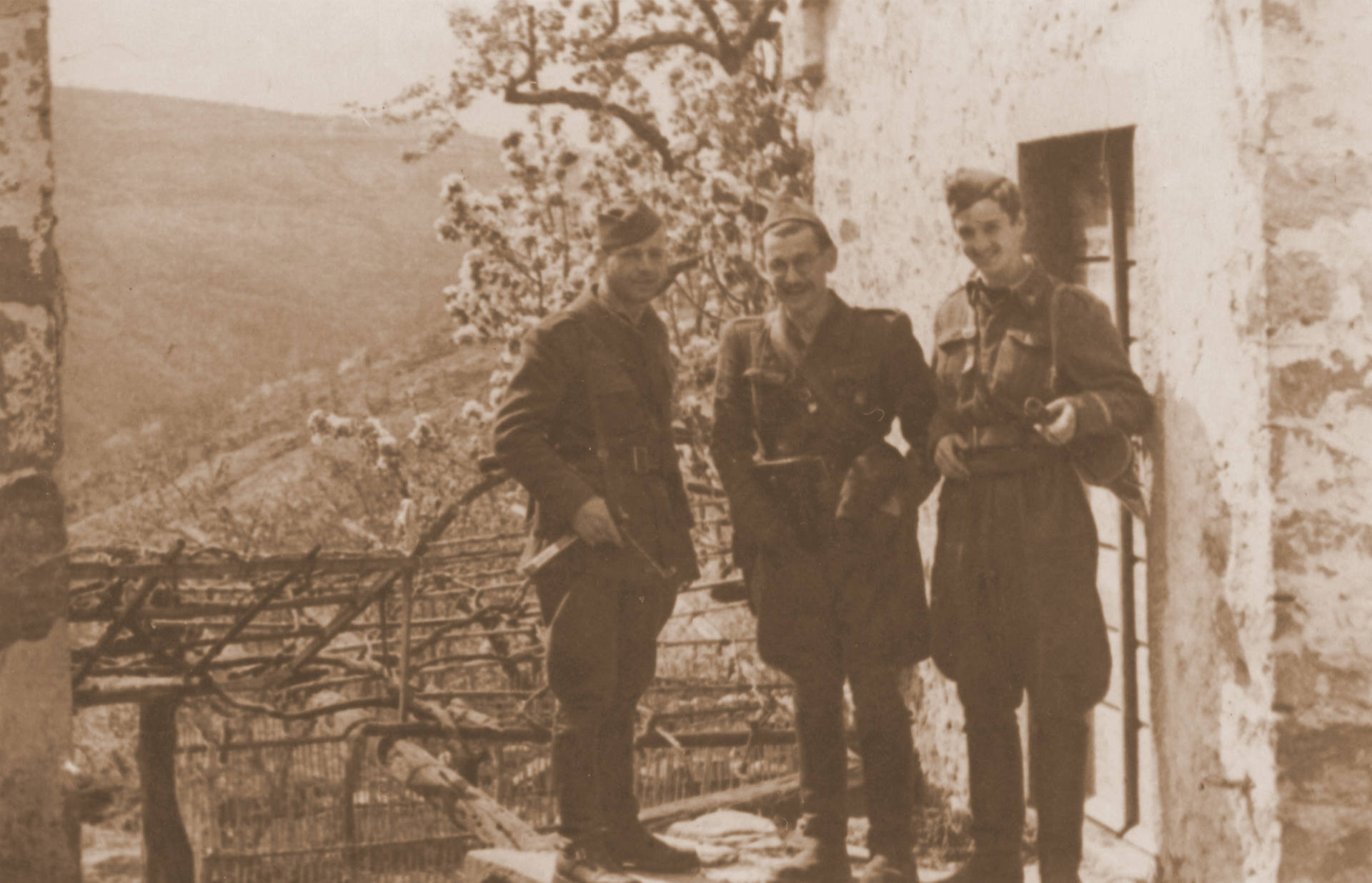 Members of the district committee of the KPS for the Southern Primorska district in spring 1945, with secretary France Perovšek in the middle.
Members of the district committee of the KPS for the Southern Primorska district in spring 1945, with secretary France Perovšek in the middle.
Elections to local national liberation committees in the Southern Primorska district took place between July and November 1944, although in some places the presence of enemy forces meant that they could not be held at all. According to incomplete data, around 130 of the 287 electoral units actually voted. Representatives for (local) district assemblies were elected at the same time. The latter quickly held constituent assemblies at which executive committees and district courts were appointed and a representative was elected to the (wider) district assembly. The wider district assembly met for the first time in Padež on 11 October 1944 and elected an executive committee headed by Jože Prosen, alias Radivoj. The committee also included representatives of the clergy and of Italian antifascist organisations.
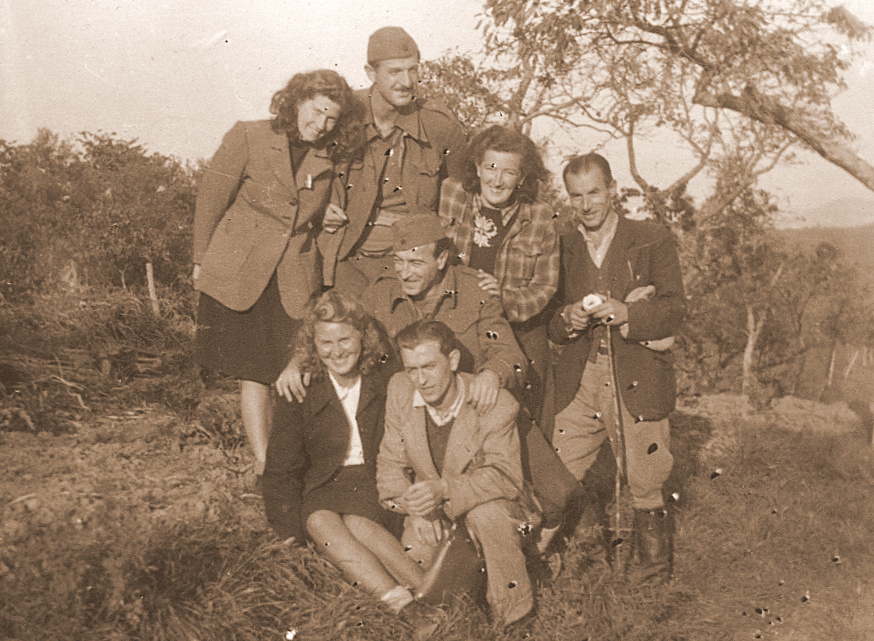 Members of the Liberation Front committee for the newly established Southern Primorska district in August 1944.
Members of the Liberation Front committee for the newly established Southern Primorska district in August 1944.

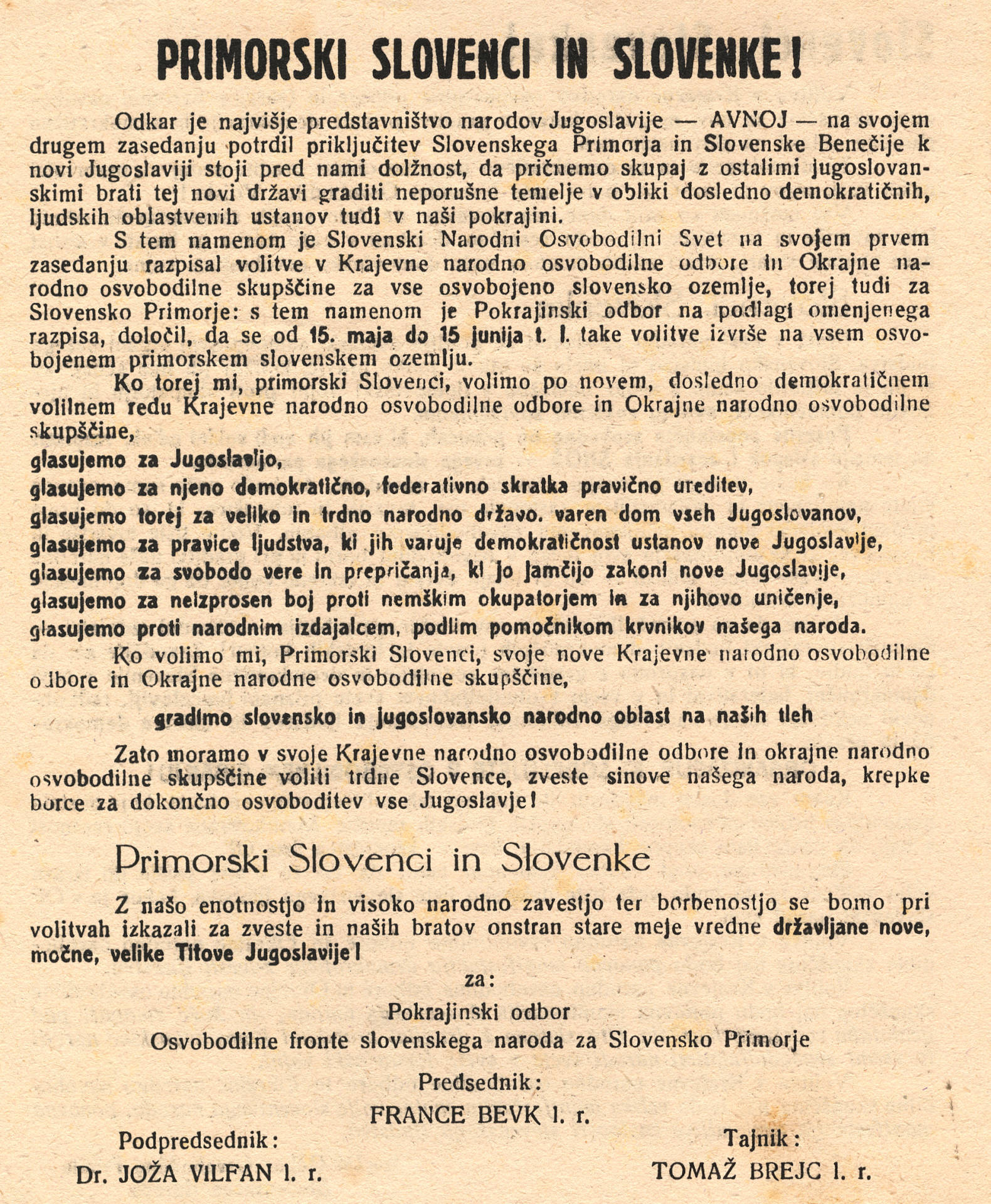
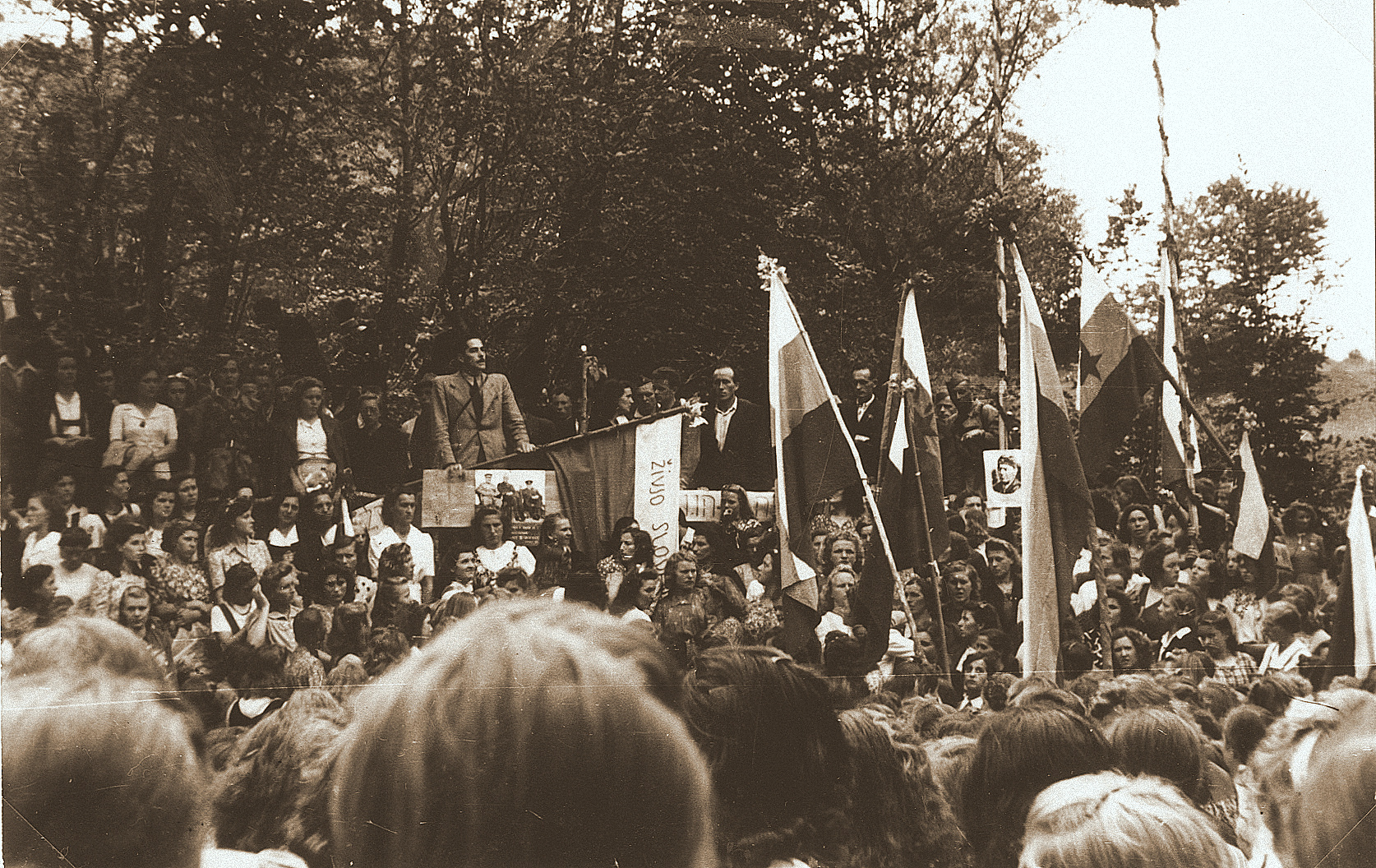 Electoral rally in the Šmagor, in the Brkini Hills, on 7 July 1944. The rally was attended by around 2,000 people.
Electoral rally in the Šmagor, in the Brkini Hills, on 7 July 1944. The rally was attended by around 2,000 people.
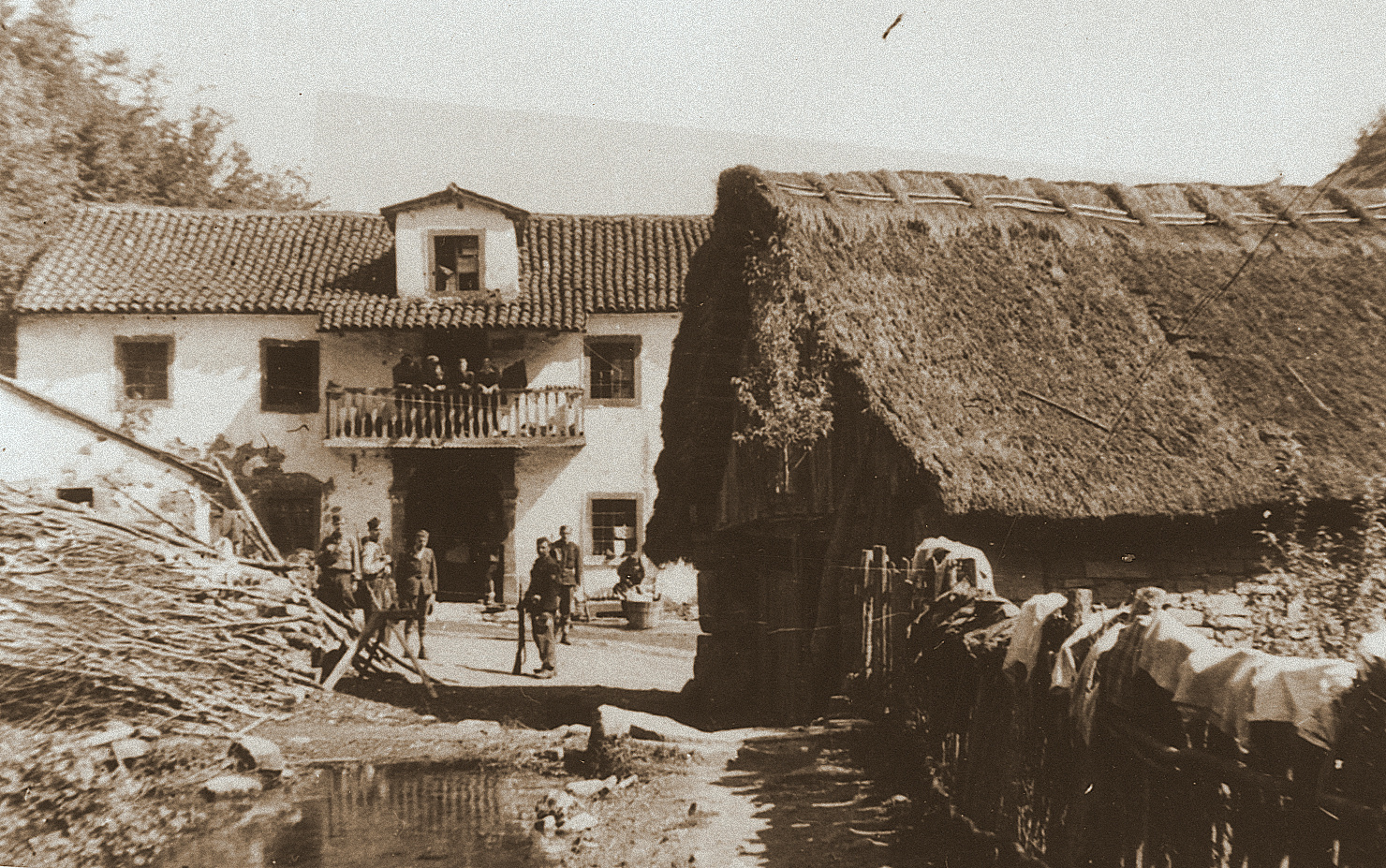 Šprohar’s Farm in Padež. It was here that the constituent assembly of the national liberation committee for the wider Southern Primorska district met on 11 October 1944.
Šprohar’s Farm in Padež. It was here that the constituent assembly of the national liberation committee for the wider Southern Primorska district met on 11 October 1944.
During the summer and early autumn of 1944 a campaign was also conducted to popularise the agreement between Tito and Ivan Šubašić, the prime minister of the Yugoslav government-in-exile, and the speech given by Tito on the island of Vis on 10 September 1944, when he pronounced the famous words “We do not want what belongs to others, but we will not give what is ours!”, in this way announcing the firm demand that Primorska and Istria be part of Yugoslavia.
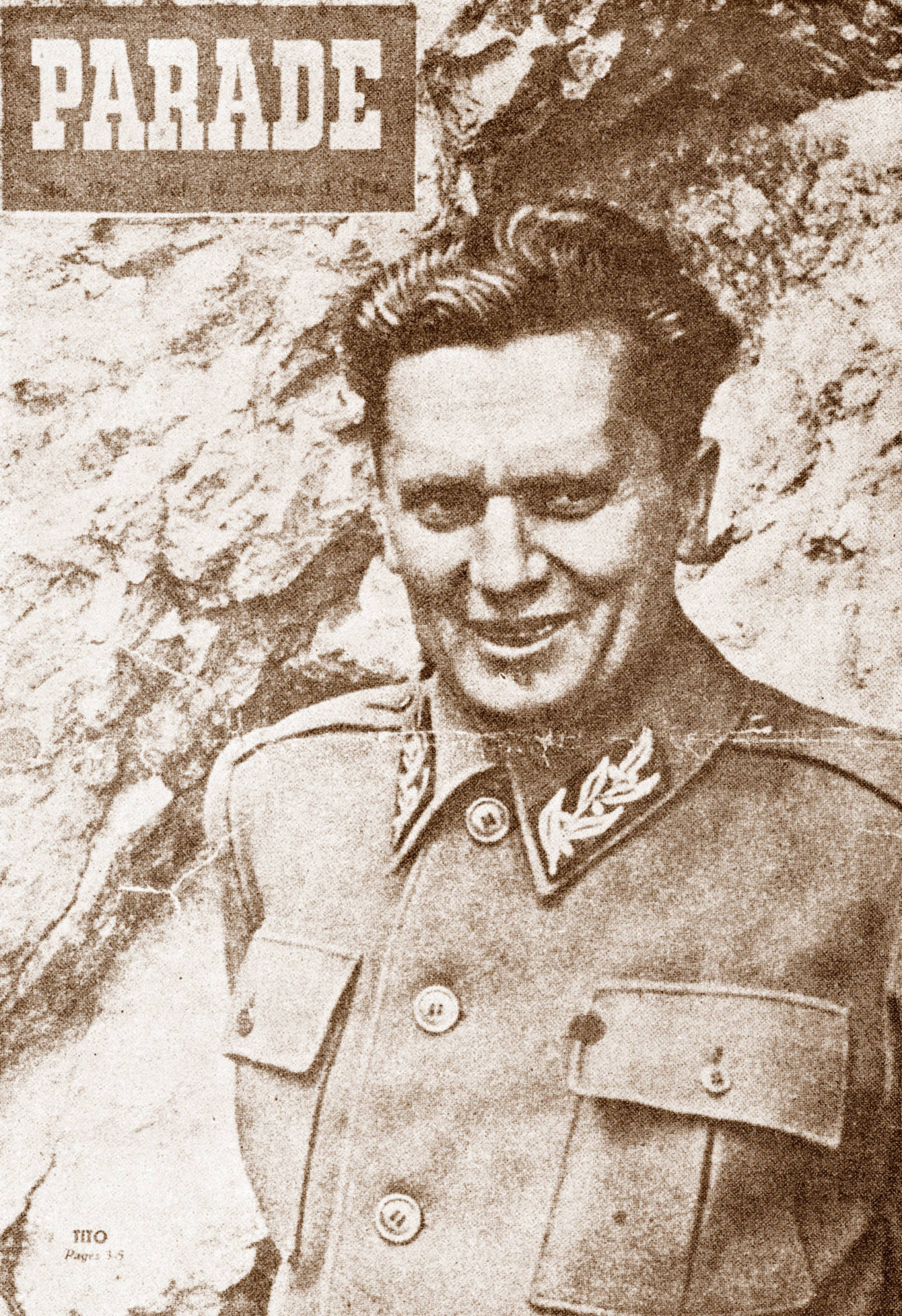 Josip Broz Tito, the leader of the Yugoslav national liberation struggle. The 3 June 1944 edition of Parade magazine, which was published in Cairo during the Second World War, carried a photograph of Tito on the cover and contained an article on him. The photographs from this article were reprinted by numerous publications around the world.
Josip Broz Tito, the leader of the Yugoslav national liberation struggle. The 3 June 1944 edition of Parade magazine, which was published in Cairo during the Second World War, carried a photograph of Tito on the cover and contained an article on him. The photographs from this article were reprinted by numerous publications around the world.
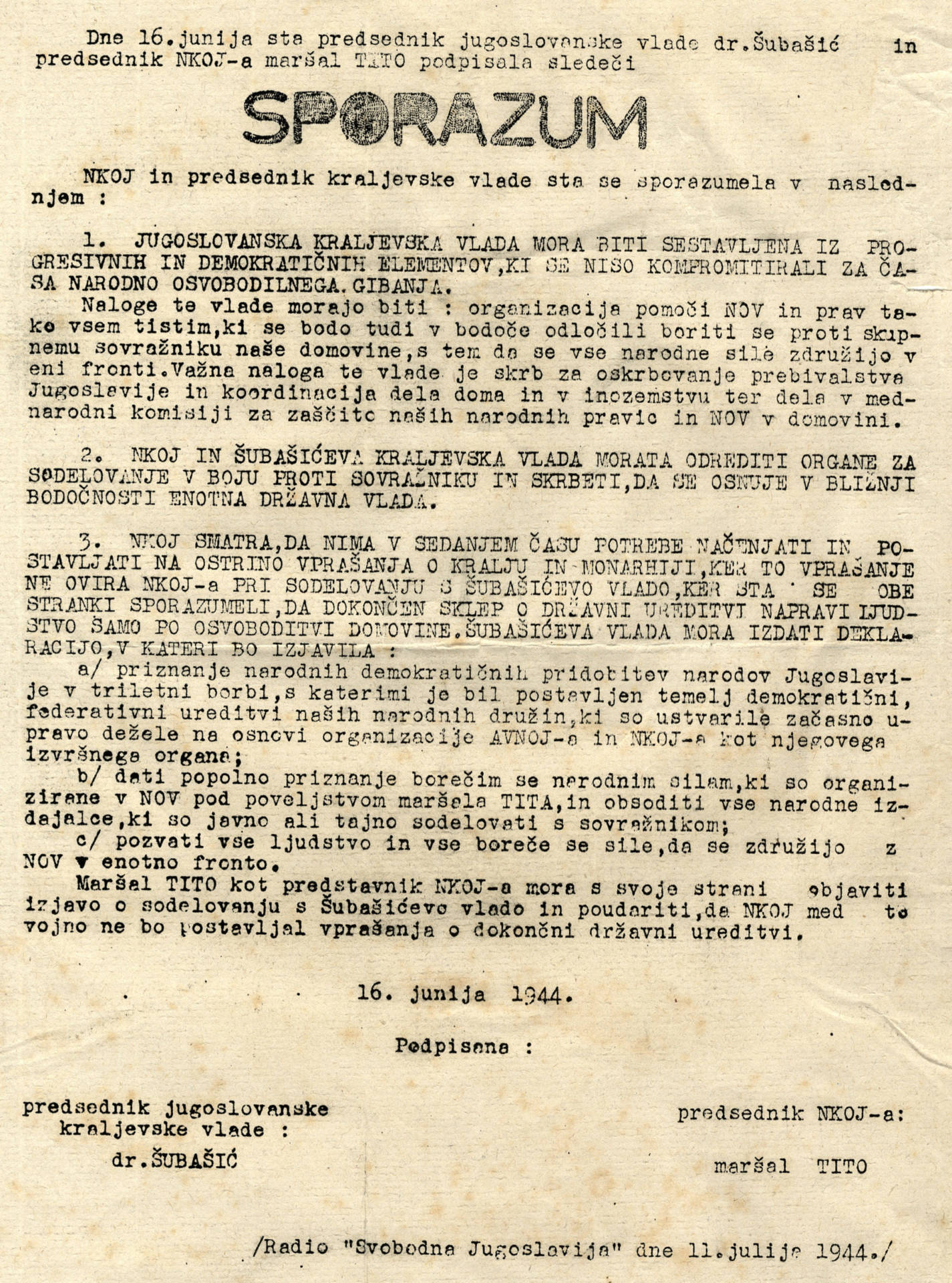 Agreement between the National Committee for the Liberation of Yugoslavia (NKOJ) and the royal Yugoslav government-in-exile, signed on 16 June 1944 and known as the Tito–Šubašić Agreement.
Agreement between the National Committee for the Liberation of Yugoslavia (NKOJ) and the royal Yugoslav government-in-exile, signed on 16 June 1944 and known as the Tito–Šubašić Agreement.
 Quotation from speech given on the island of Vis.
Quotation from speech given on the island of Vis.
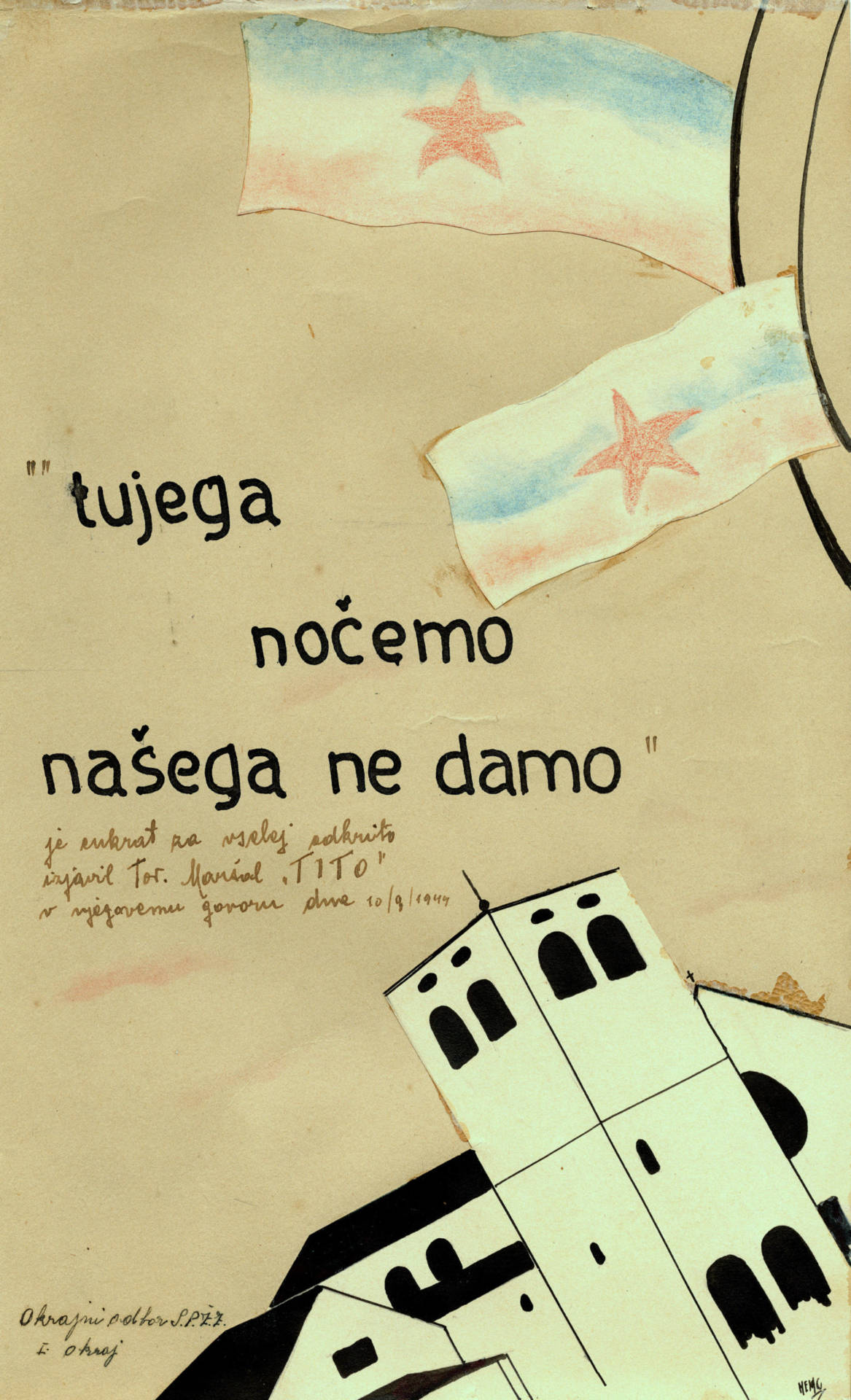 Letters sent to Tito from popular rallies thanking him for his words on the incorporation of the region into Yugoslavia.
Letters sent to Tito from popular rallies thanking him for his words on the incorporation of the region into Yugoslavia.
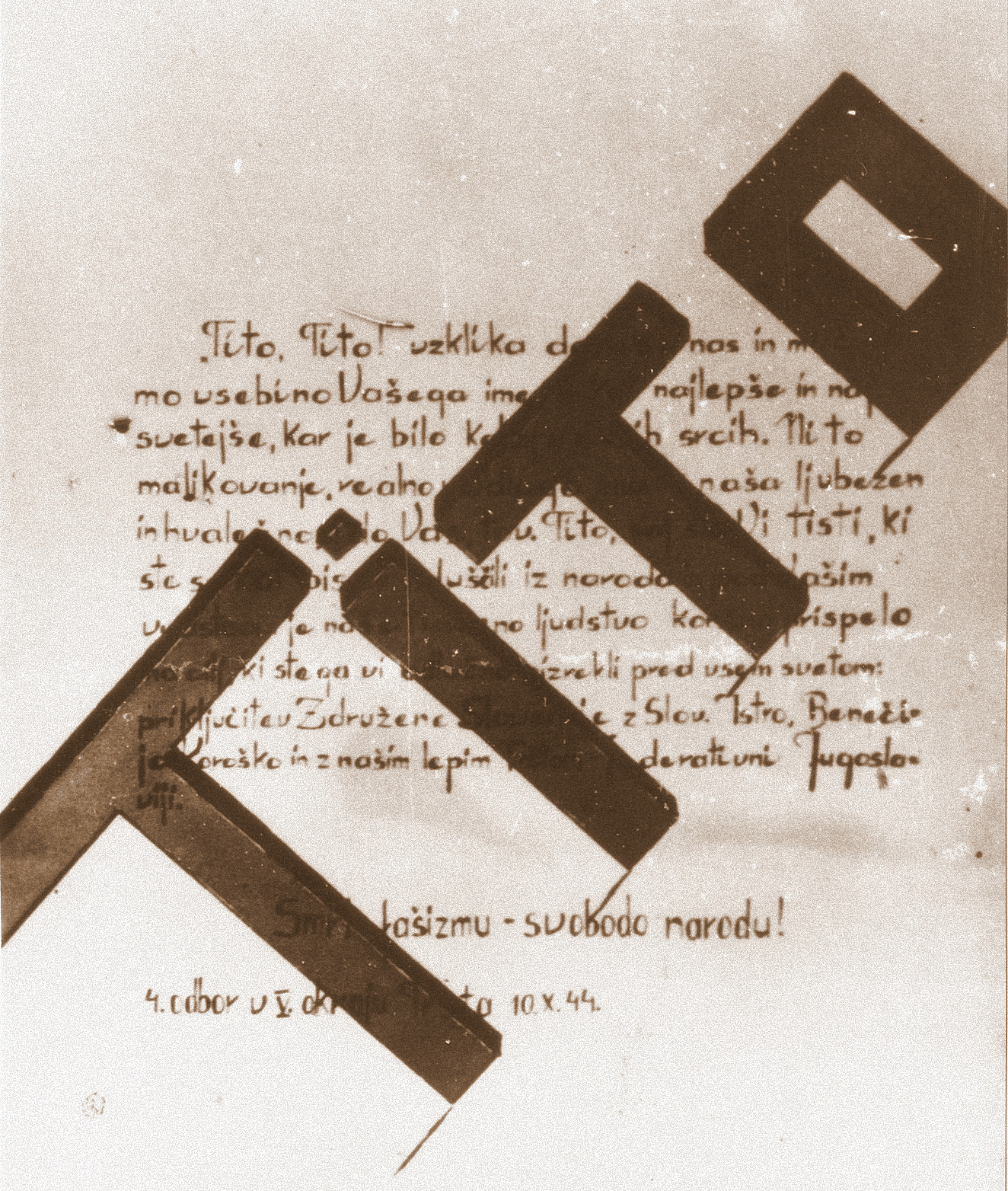 Letters sent to Tito from popular rallies thanking him for his words on the incorporation of the region into Yugoslavia.
Letters sent to Tito from popular rallies thanking him for his words on the incorporation of the region into Yugoslavia.
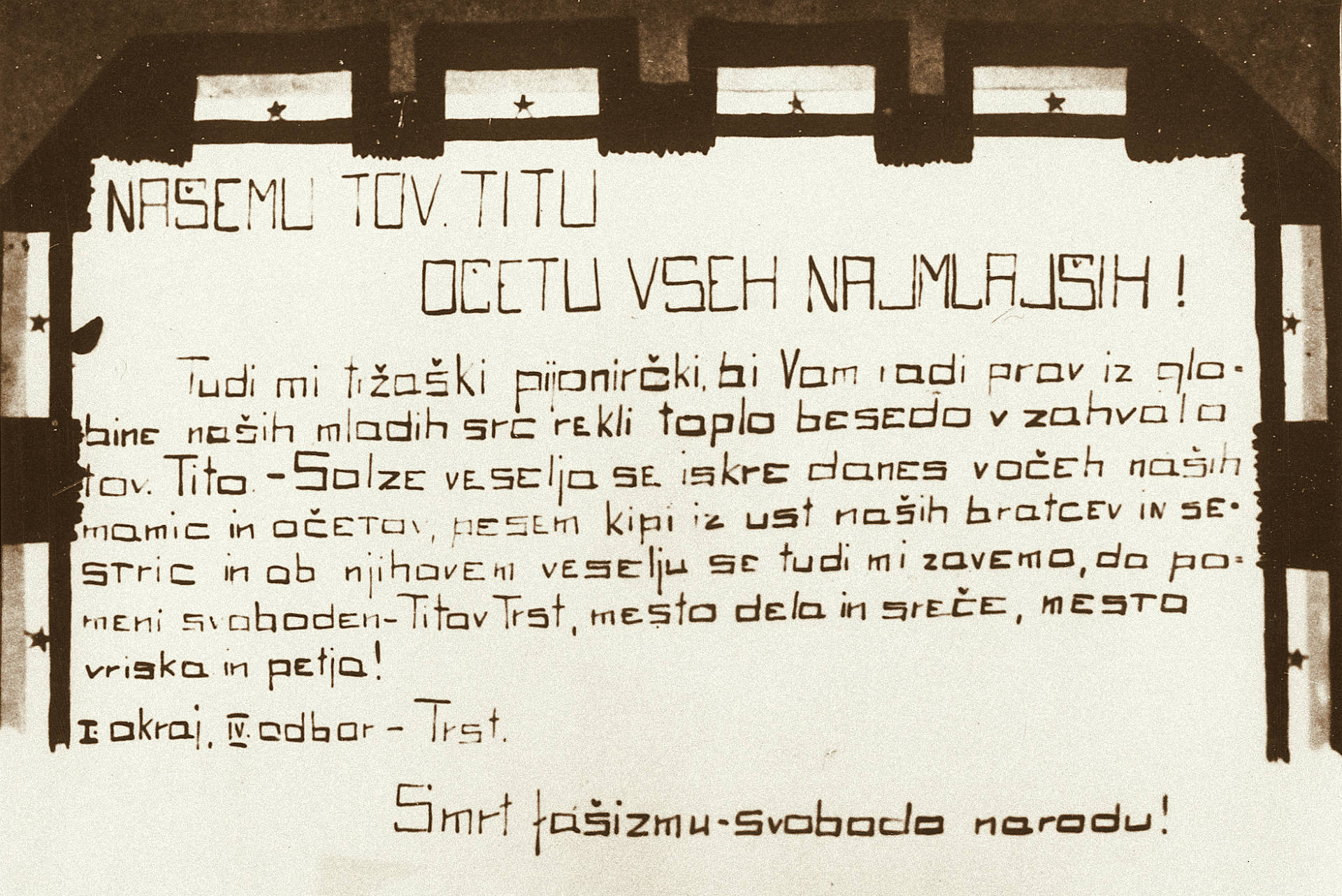 Letters sent to Tito from popular rallies thanking him for his words on the incorporation of the region into Yugoslavia.
Letters sent to Tito from popular rallies thanking him for his words on the incorporation of the region into Yugoslavia.
In the towns and cities of the coast, the Italian antifascist movement strengthened and spread from autumn 1943 onwards. In organisational terms it was connected on the one hand with the Communist Party of Italy (CPI) and the National Liberation Committee (Comitato di Liberazione Nazionale or CLN) in Trieste, and on the other with the Slovene national liberation movement and Partisan units. The most active members of the movement were its youth members: young Communists who carried out acts of sabotage and other actions. They were organised into Patriotic Action Groups (Gruppi d’Azione Patriottica or GAP) and gathered information, food, weapons and cigarettes for the Partisans and activists, helped mobilise the populace, and so on.
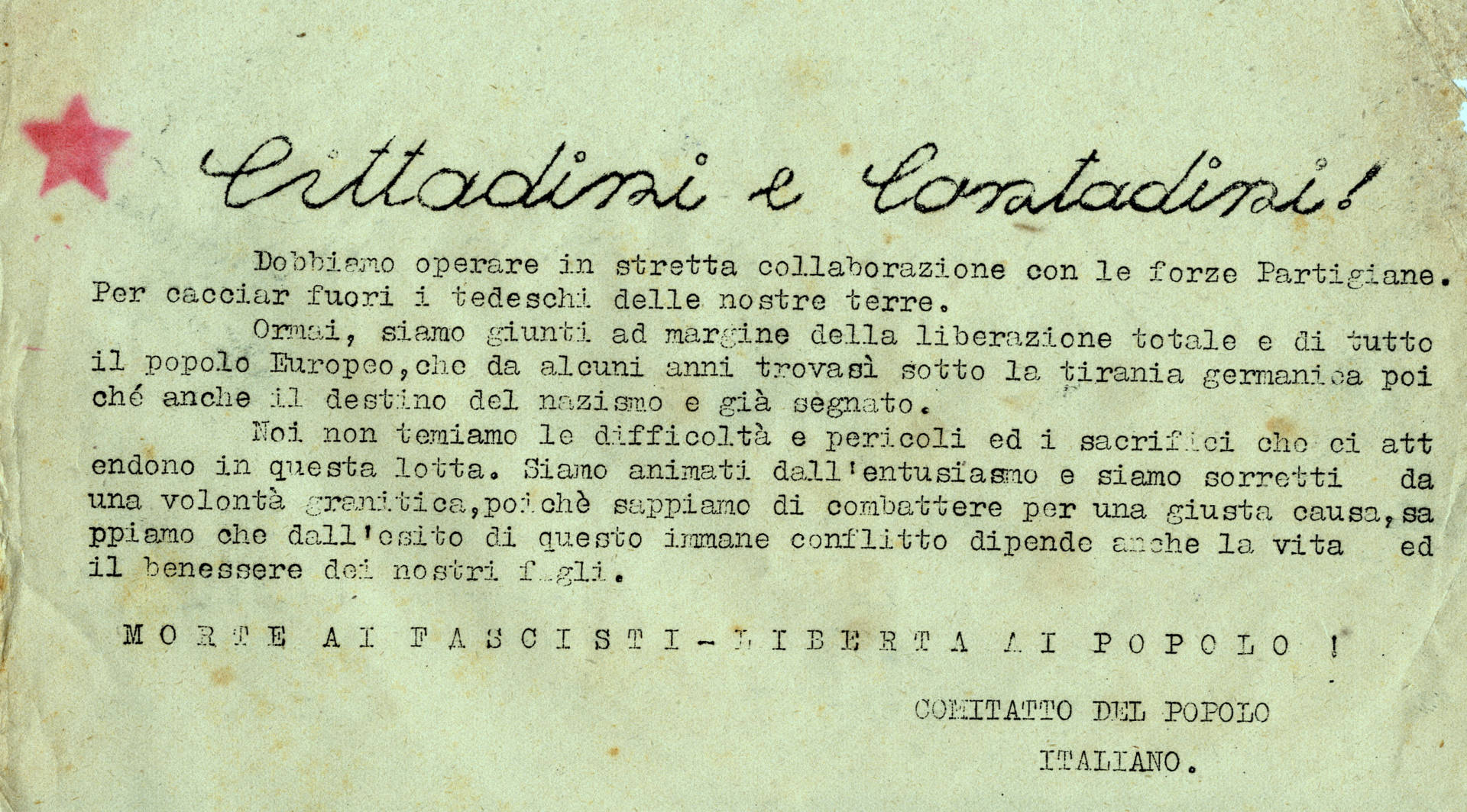
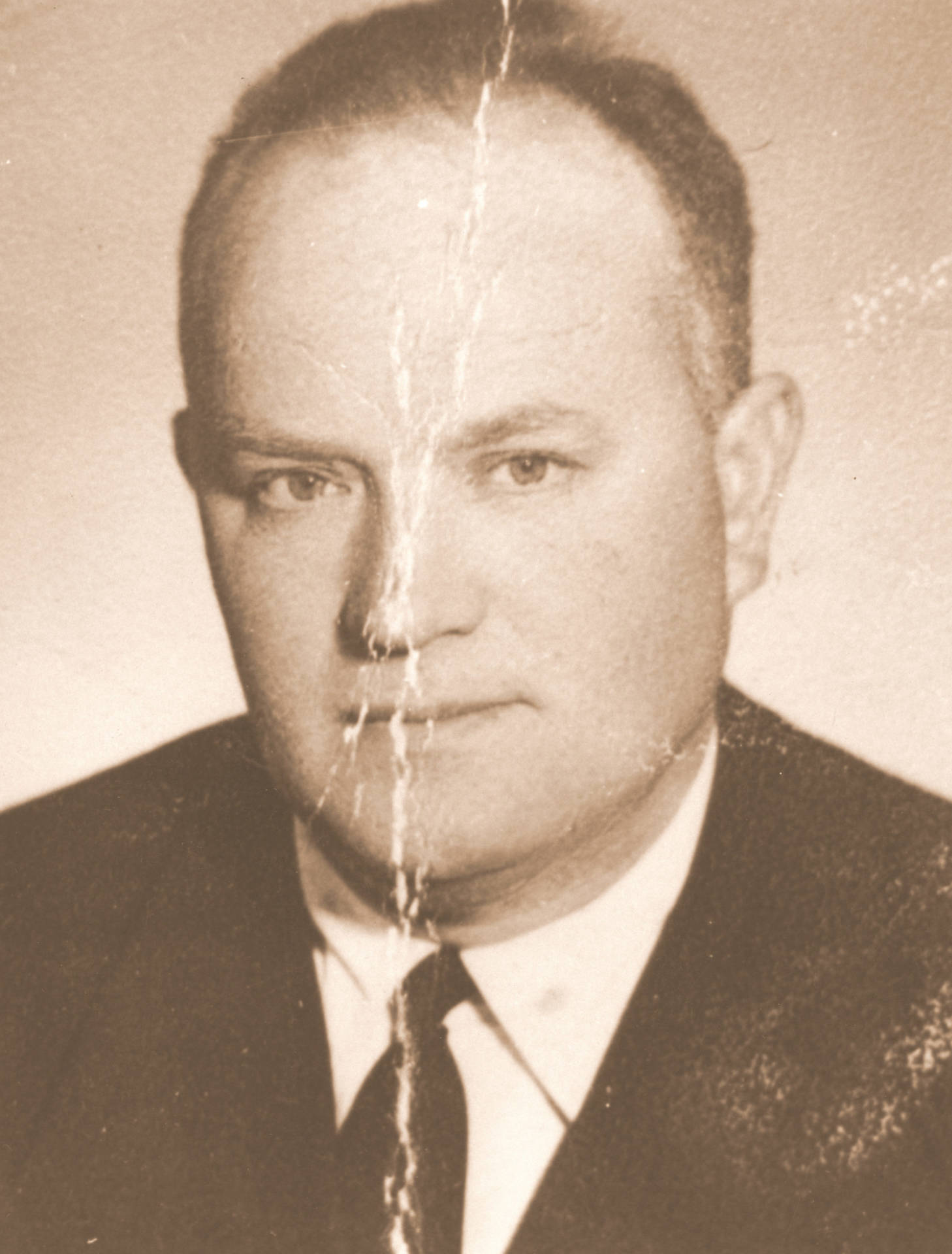 Alberto Lonzar, alias Oscar, from Koper, an important collaborator of activists in Slovene Istria and member of the executive committee of the national liberation committee for the Lopar district.
Alberto Lonzar, alias Oscar, from Koper, an important collaborator of activists in Slovene Istria and member of the executive committee of the national liberation committee for the Lopar district.
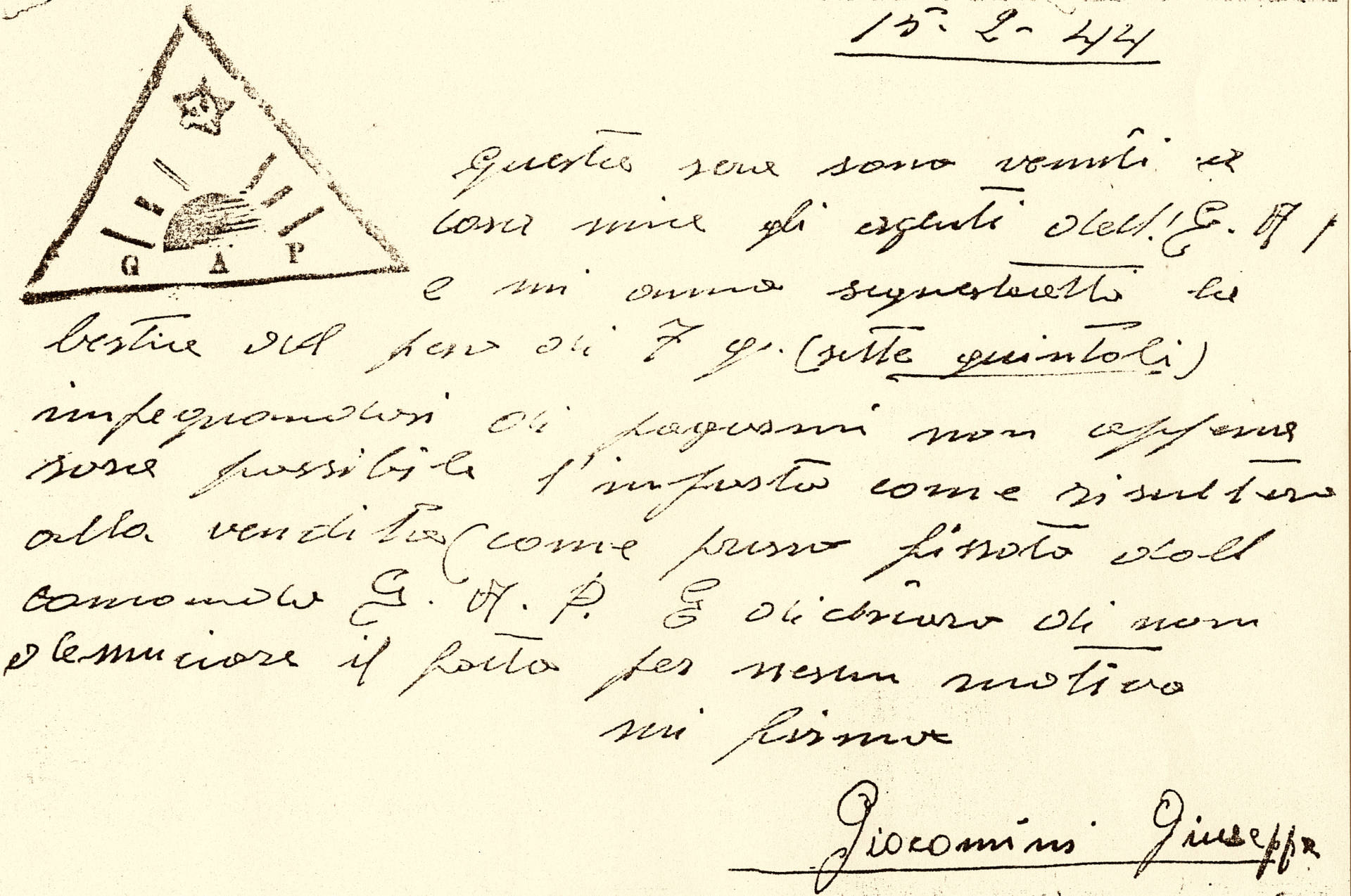 Receipt with the stamp of a GAP sabotage group. Patriotic Action Groups were organised in all the coastal towns. In Izola the GAP was led by Guerrino Degrassi, alias Darko, while the GAP in Koper was headed by Alberto Lonzar. At the end of October 1943, a special GAP was set up under the leadership of Mario Tul, alias Cicogna, as a kind of military coordination centre for all the groups from Trieste to Buje.
Receipt with the stamp of a GAP sabotage group. Patriotic Action Groups were organised in all the coastal towns. In Izola the GAP was led by Guerrino Degrassi, alias Darko, while the GAP in Koper was headed by Alberto Lonzar. At the end of October 1943, a special GAP was set up under the leadership of Mario Tul, alias Cicogna, as a kind of military coordination centre for all the groups from Trieste to Buje.
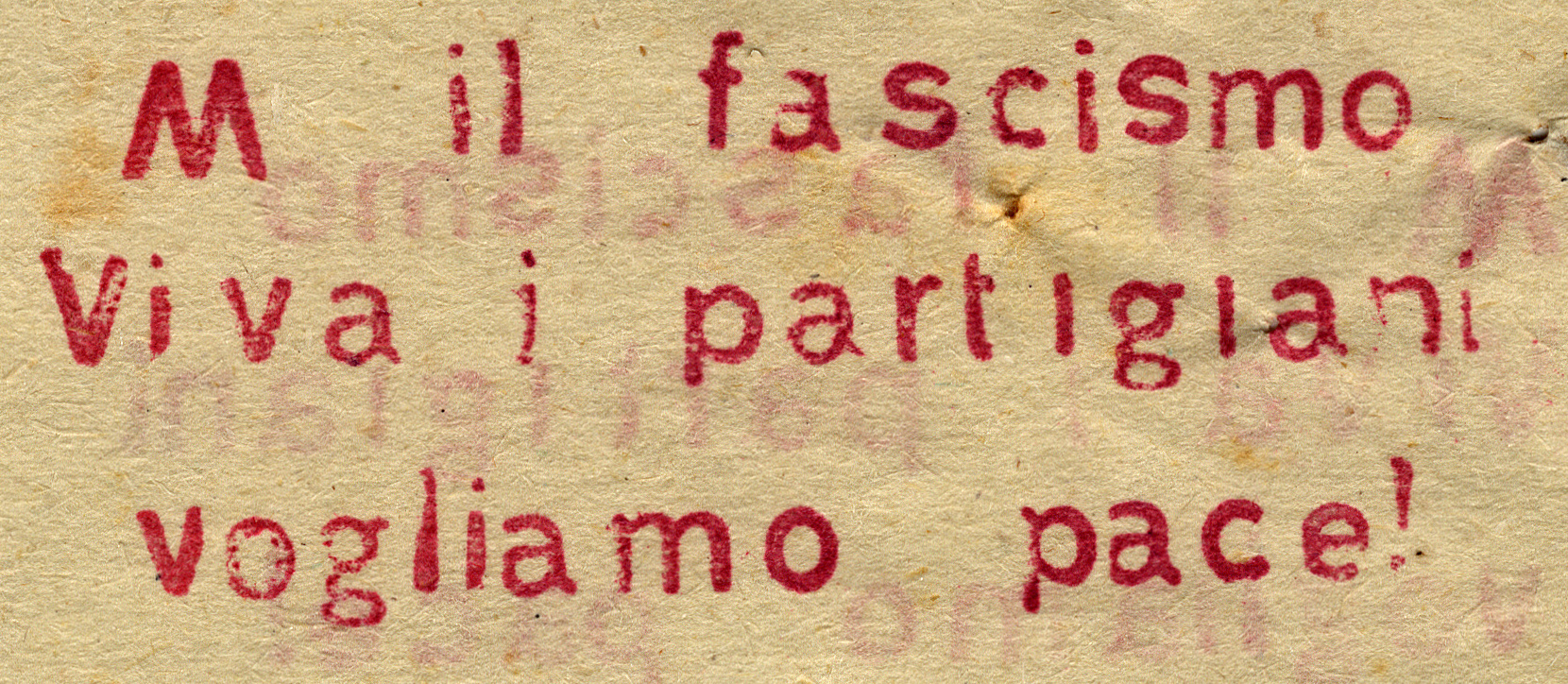
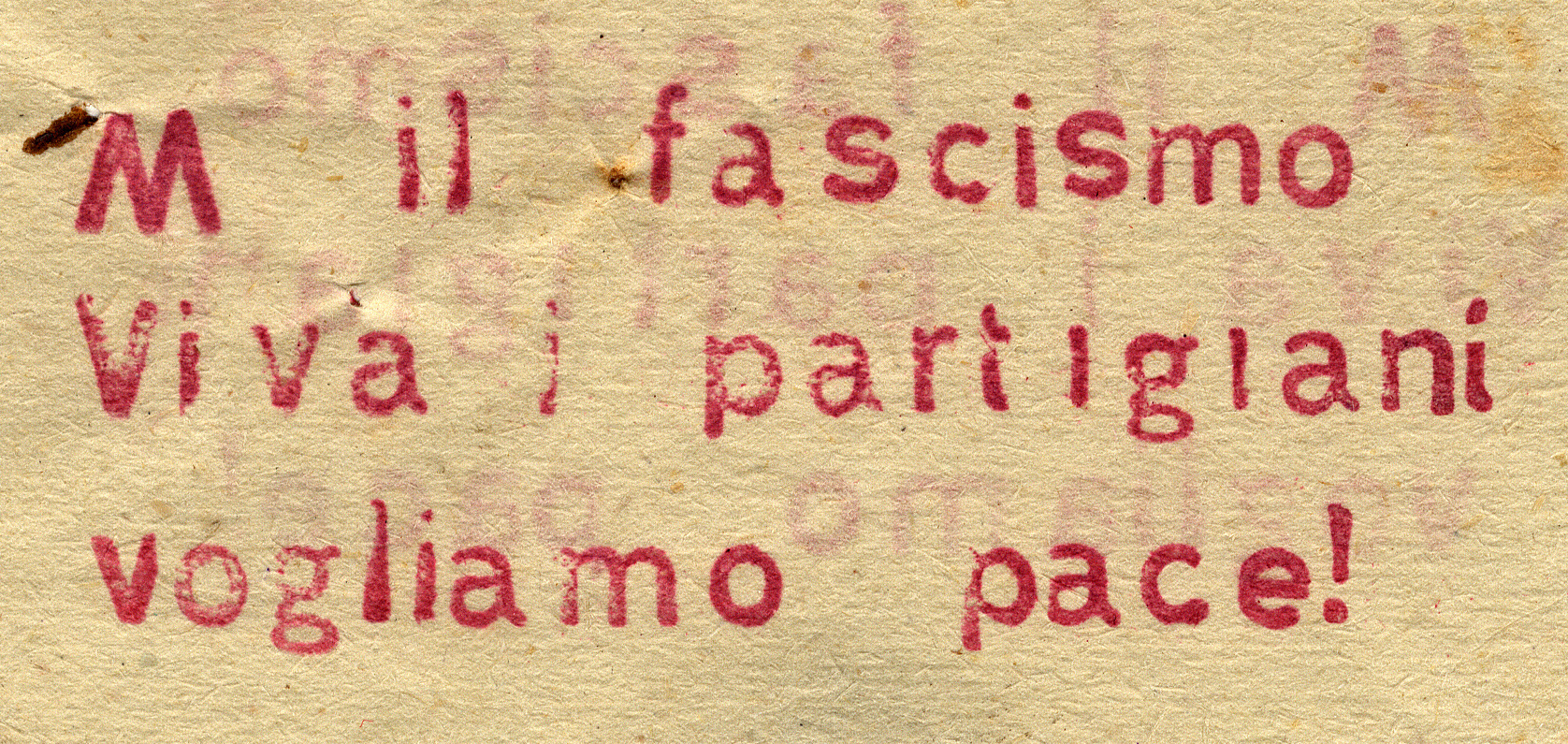
SOUTHERN PRIMORSKA PRINTING SHOP – NAŠ DOM – SNEŽNIK – F-35
It began operation on 15 May 1943 on the orders of the district committee of the KPS for southern Primorska. It was organised by Milan Guček, together with Vidko Hlaj, and run by him until June 1943. It was originally located in a bunker below Gabrovica that once housed a still, but was soon moved to a new bunker dug in the steep slope of a hill called Tinjan near Bertoši. The printing office was named Naš Dom (“Our Home”) and was taken over by Lado Trobevšek, alias Jodi. In November 1943 it was renamed Snežnik (after the nearby mountain) and moved again, first to a cave above the village of Osp, then to Gabrovica, then, in March 1944, back to Osp, then back to a cave above Osp, where it remained until October 1944. Until October 1943 it was run by Trobevšek, then until June 1944 by Just Miklavc, alias Očka. The latter was replaced by Anica Cizej, alias Marjanca, who ran the Žena printing shop, which merged with Snežnik at the end of May 1944. The printing office duplicated literature for the Brkini and Slovene Istria districts, while also sending some literature to Pivka and Trieste. Communications with the printing shop were maintained by courier station P-1.
